Analyzing Inline Web In-line Campaigns
Once you launch a Web In-line campaign through the channel or a journey, its impact on user engagement and revenue can be analyzed in detail through Campaign Overview.
How to Access
Let's quickly show you how you can access campaign analysis through the various sections of your dashboard:
Access Campaign Overview through List of Campaigns
A list of all the campaigns created through the channel can be found under the List of Campaigns section or the central hub of Web In-line Content. You can click on the (hyperlinked) Campaign’s Name to analyze a campaign in further detail.
Access Campaign Overview through Segment Overview
A list of all the campaigns sent to a segment of users can be found under Campaigns in the [segment's overview](analysing-segments #section-4-campaigns) section. You can click on the (hyperlinked) Campaign Name to analyze the Web In-line campaign in further detail.
Before we dive into campaign analysis, let's get you acquainted with the top panel.
Understanding Top Panel

Click to enlarge
As highlighted above, the top panel provides a quick snapshot of the campaign with key details like:
-
Campaign Name: As defined at Step 1: Audience, while creating the campaign.
-
(Target) Audience: Indicates the segment targeted by the campaign, as defined at Step 1: Audience, while creating the campaign.
-
(Campaign)Type: Given the highly targeted nature of Web In-line, all campaigns created through the channel are considered to be Triggered campaigns by default.
-
(Campaign)Status: Indicates the current status of the campaign.
- If you save a campaign without launching it, then it will be saved as a draft. The same is reflected by the status, Draft.
Now, let's get you acquainted with its features:
Modify Campaign
As shown below, using the icons placed next to the Campaign's Name, you can choose to Edit, Delete, Duplicate, Pause/Resume and Tag the campaign, as per your marketing needs.

Click to enlarge
- Once you Pause a Running campaign, you can choose to Resume it's delivery to the target audience by clicking the Resume icon, as highlighted above.
Related Read: Modifying Web In-line CampaignsA step-by-step guide on how you can modify Web In-line campaigns.
Download a Report
Please NoteReports can be downloaded only by Admins who have access to Account Management. If you are unable to do so, then please get in touch with the account owner.
You can easily download a copy of campaign stats for offline analysis, upload it to another platform, and so on. Here's how you can go about it:
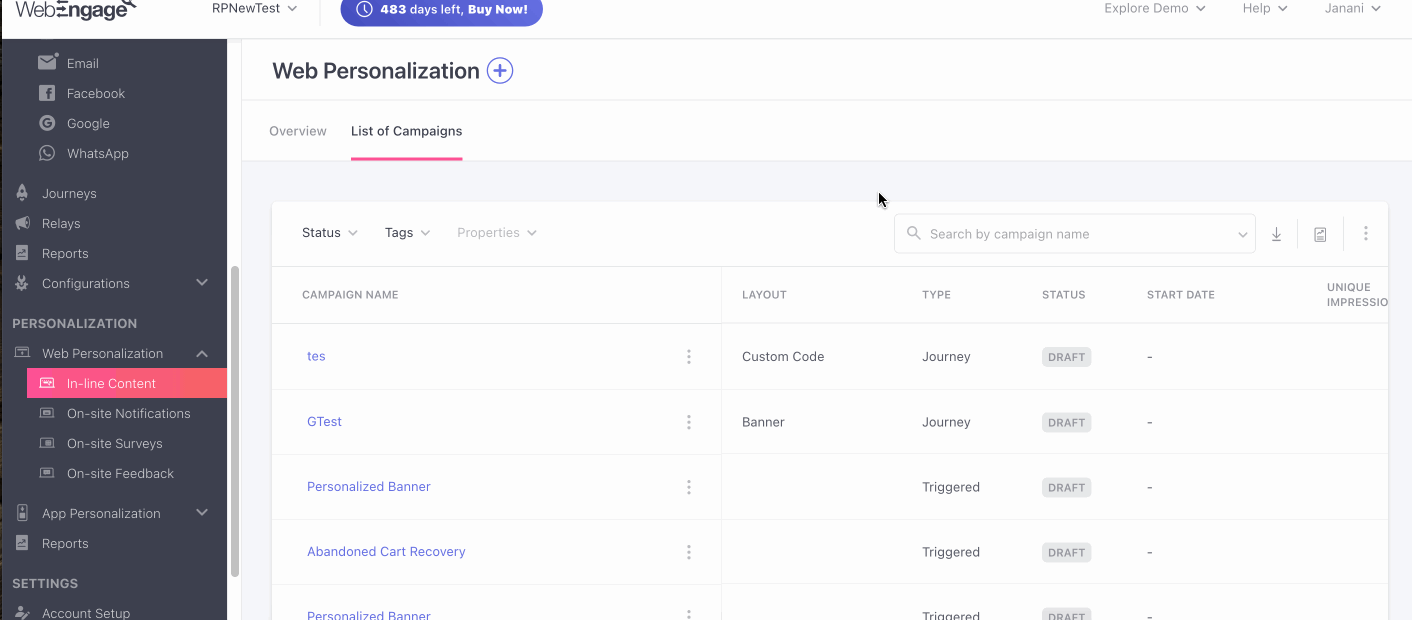
Click to enlarge
Step 1: Click theDownload icon
As shown above, in doing so, you will be prompted to specify the kind of data you want to analyze.
Step 2: Specify the time frame for which the stats should be shown(Data to Include)
As shown above, you can specify the time frame as:
- Campaign's Start Date till Present Date
- Custom Dates
Detailed Read
How Data to Include works
Step 3: Select Data Breakdown
In this dropdown you can choose from 4 options i.e. _Day-wise, Week-wise, Month-wise, and 30 days rolling window. _Each of these have been explained below.
- Day-wise: When you choose the day-wise option the report that will be sent to you will have an aggregate of each day i.e. each row will consist of each campaign or variations day wise statistics.
For example, if you want to download a report for the last 7 days, by choosing the day wise data breakdown option, you will receive a report with 7 rows each containing data for each of the days. - Week-wise: When you choose this option the report will consist of the aggregate of each week, i.e. Every row will contain the week-wise statistics for each campaign or variation, with each week defined from Monday to Sunday.
For instance, if you download a report for the past 1 month on the 30 Nov ’23 , and set the data breakdown option to week-wise, then you will receive a report that consists of 5 rows of aggregated data for each week starting from Monday to Sunday. Whereas, if a month starts during the middle of the week, for example the 1st of the month is on a Thursday, then the row for the first week will be from Thursday to Sunday. - Month-wise: On choosing this option your statistics will be aggregated for each month i.e. each row will consist of month wise statistics. (calendar month will be considered)
If you wish to download a report spanning from January 1st to November 30th and select the month-wise data breakdown option, you will receive 11 rows. Each row will contain aggregated data for each respective month, providing a comprehensive breakdown of information (based on calendar month). - 30 day (Rolling window): On choosing this option, your statistics will be aggregated based on every 30 days irrespective of the calendar month, i.e. Every row will include the rolling window statistics for each campaign or variation for up to 30 days.
For example, if you choose a date range from 15th June to 14th August, two rows will be generated i.e. 15th June to 14th July and 15th July to 14th August.
Step 4: Specify Level of Data Granularity
You can create up to 5 versions of a campaign and test each one to determine the copy that resonates with your audience. Thus, while downloading a report, you can choose to analyze consolidated campaign stats OR a variation-wise breakdown.
As shown above:
-
Select Campaign Level Granularity to view the average performance of all campaign variations.
-
Select Variation Level Granularity to view the individual performance of each variation and identify the top-performing version.
Step 5: Click Download
Schedule a Report
In our quest to make campaign reporting a seamless experience, we built Scheduled Reports - customizable and automated reports delivered straight to your inbox!

Click to enlarge
As highlighted above, using the Reporting icon, you can set up a periodic report to have all the stats shown under Overview, emailed to multiple team members.
Here's how you can go about it:

Click to enlarge
Step 1: Click on theReporting icon
- As shown above, in doing so, you will be prompted with a pop-up allowing you to customize the report's settings.
- The report's name will be the same as the campaign's name. This will be included in:
- The emailed report's subject line
- under the Scheduled Reports section of your dashboard
Step 2: Define theFrequency of report delivery
You can choose to have a report delivered on a Daily, Weekly, or Monthly basis, as per your needs.
- As shown above, we have selected Weekly as the Frequency for our report.
Step 3: Specify the time of delivery(When)
As shown above, you can choose to have the report delivered at a specific time of the day. The same can be defined in an AM/PM format against the field, When.
Step 4: Specify the time frame for which the stats should be shown(Data to Include)
Too many data points always lead to chaotic insights. This is why we have made it possible for you to specify the time frame (number of days) for which you'd like to receive campaign stats.
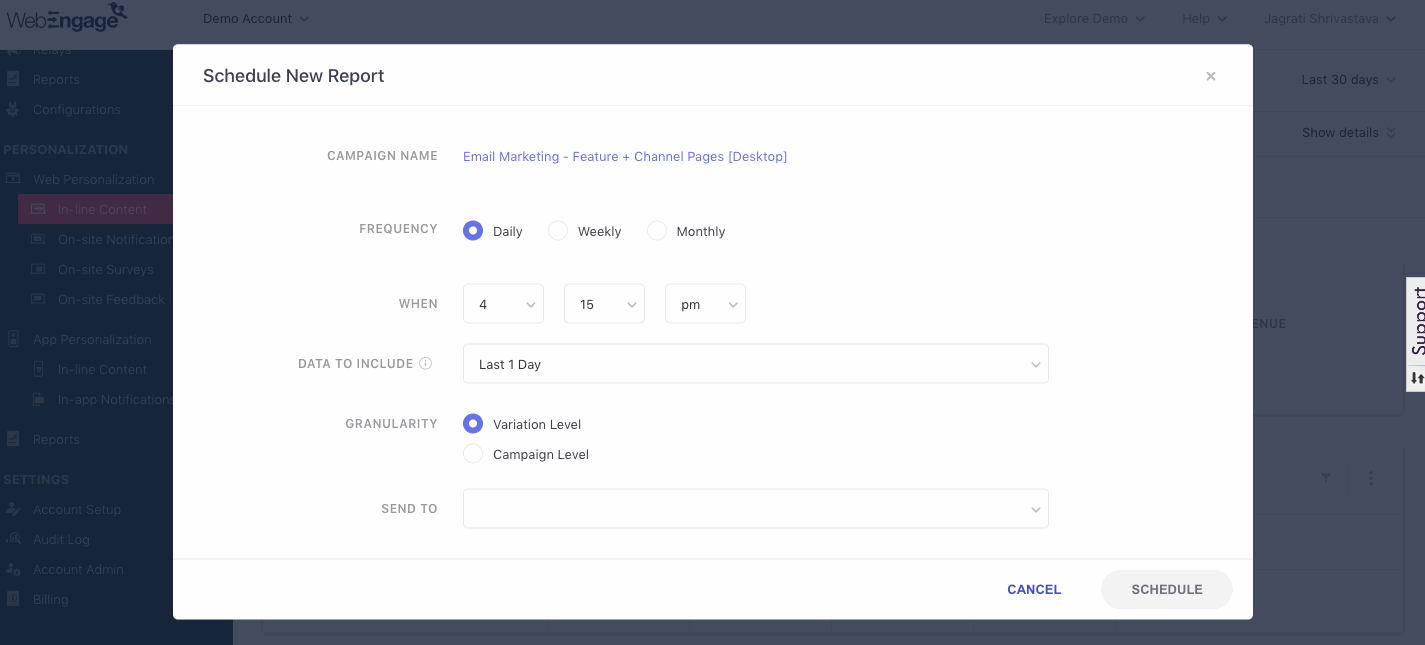
Click to enlarge
As shown above, you can select a time frame between Last 1 Day to Last 30 Days_against _Data to Include.
Detailed Read
How Data to Include works
How a combination of Data to Include & Frequency determine the date of stats included in the report
Step 5: Select option for Data Breakdown
In this dropdown you can choose from 4 options i.e. Day-wise, Week-wise, Month-wise, and 30 days rolling window. Each of these have been explained below.
- Day-wise: When you choose the day-wise option the report that will be sent to you will have an aggregate of each day i.e. each row will consist of each campaign or variations day wise statistics.
- Week-wise: When you choose this option the report will consist of the aggregate of each week, i.e. Every row will contain the week-wise statistics for each campaign or variation, with each week defined from Monday to Sunday.
- Month-wise: On choosing this option your statistics will be aggregated for each month i.e. each row will consist of month wise statistics. (calendar month will be considered).
- 30 day (Rolling window)- On choosing this option, your statistics will be aggregated based on every 30 days irrespective of the calendar month, i.e. Every row will include the rolling window statistics for each campaign or variation for up to 30 days. For example, if you choose a date range from June 15th to August 14th, two rows will be generated i.e. June 15th to July 14th and July 15th to August 14th.
Click here to know more about the use cases of each.
Step 6: Select Level of Data Granularity
At WebEngage, you can create up to 5 versions of a campaign and test each one with a small test segment to determine the copy that resonates with your audience. Thus, while scheduling a report, you can choose to analyze consolidated campaign stats OR a variation-wise breakdown.
As shown below:
-
Select Campaign Level Granularity to view the average performance of all campaign variations.
-
Select Variation Level Granularity to view the individual performance of each variation and identify the top-performing version.
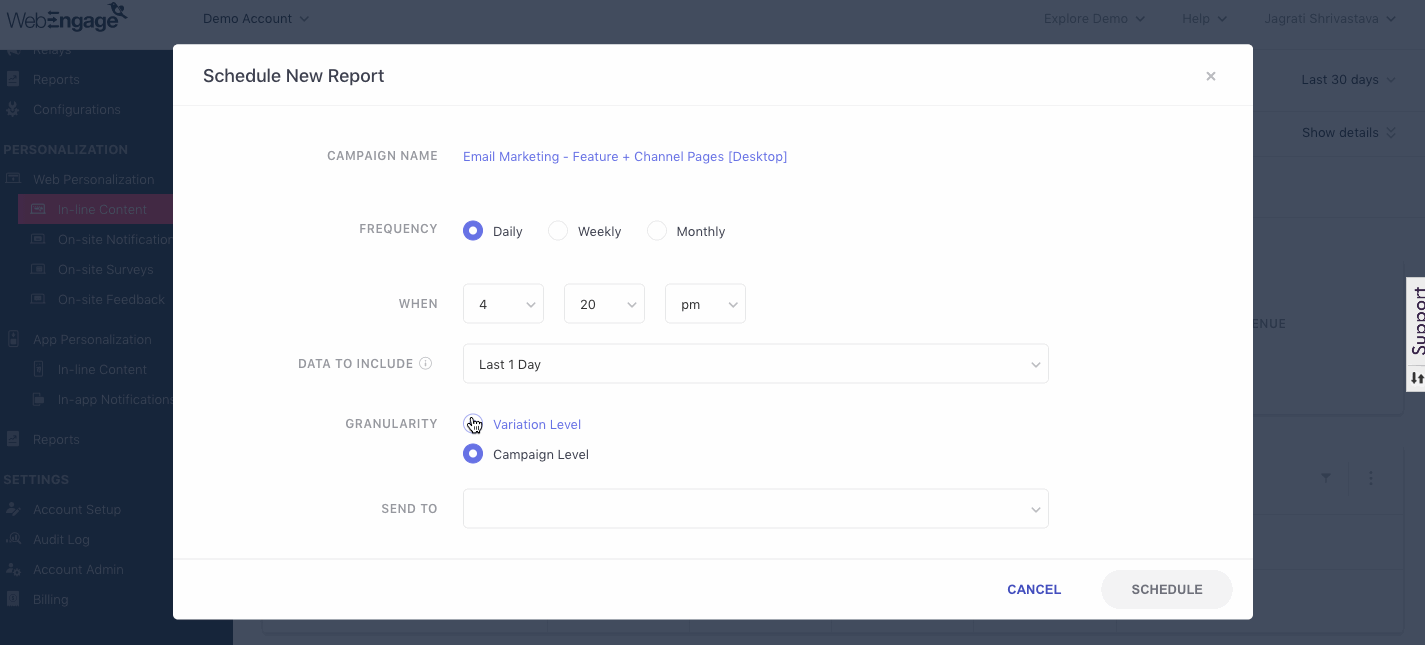
Click to enlarge
Step 7: Add team members asSubscribers
As shown above, you can choose from a list of all the team members who have access to your WebEngage dashboard. Doing so will ensure that all the added users receive the campaign performance report as per its settings.
- However, if a team member is not a part of your WebEngage account, then you will not be able to add them as a Subscriber.
Step 8: Click theSchedule button
-
A notification will pop-up on the bottom right corner of the page, confirming that the report has been scheduled. (Understanding Report Stats)
-
You can modify or delete the report anytime you like through the Scheduled Reports section, nested under Settings in your account.
Please Note
Reports can be configured by only those Admins that have access to Account Management. Please get in touch with the account owner if you're unable to do so.
You can schedule additional reports for campaigns sent through Web In-line Content and all the channels combined through Settings > Scheduled Reports in your dashboard.
See Campaign Details
As demonstrated below, clicking Show Details reveals a thorough recap of all the rules and settings specified while creating the campaign. This section can be minimized by clicking Hide Details.
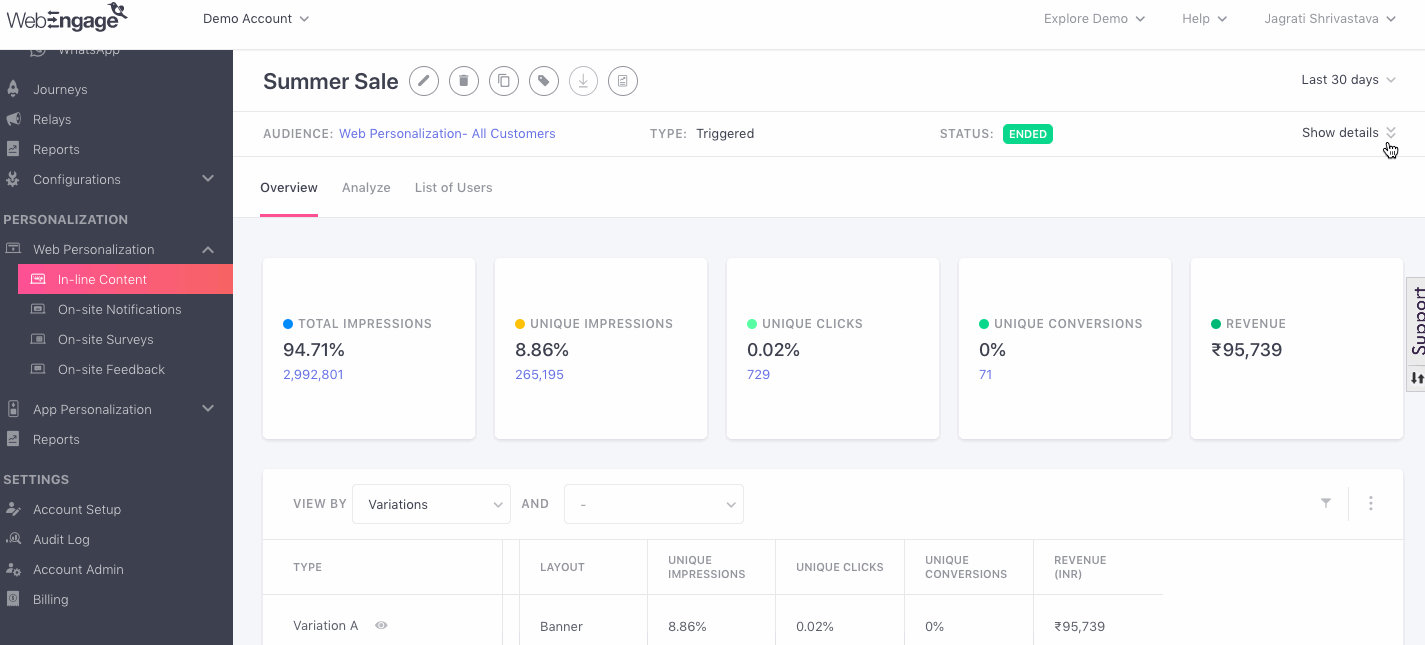
Click to enlarge
Here's a list of all the details shown here:
-
Campaign ID: A unique campaign ID is generated by us each time you create a campaign.
-
Start Date: Indicates the date-time on which the campaign was launched or will be launched (if the campaign is still scheduled), as specified at Step 2: When, while creating it.
-
End Date: Indicates the date-time on which the campaign will end or ceased getting delivered. An End Date can be specified at Step 2: When while creating it.
-
Tags: Tags is a handy feature that helps you categorize your campaigns as per their purpose, target audience, frequency, or any other parameter that makes them easier to search for.
-
If a campaign is tagged: All the tags added to the campaign will be shown here. You can click on a hyperlinked tag to add more tags to the campaign or remove existing ones.
-
If no tags have been added: As shown below, you can click on Add Tags to create new tags for the campaign and add existing ones to it.
-
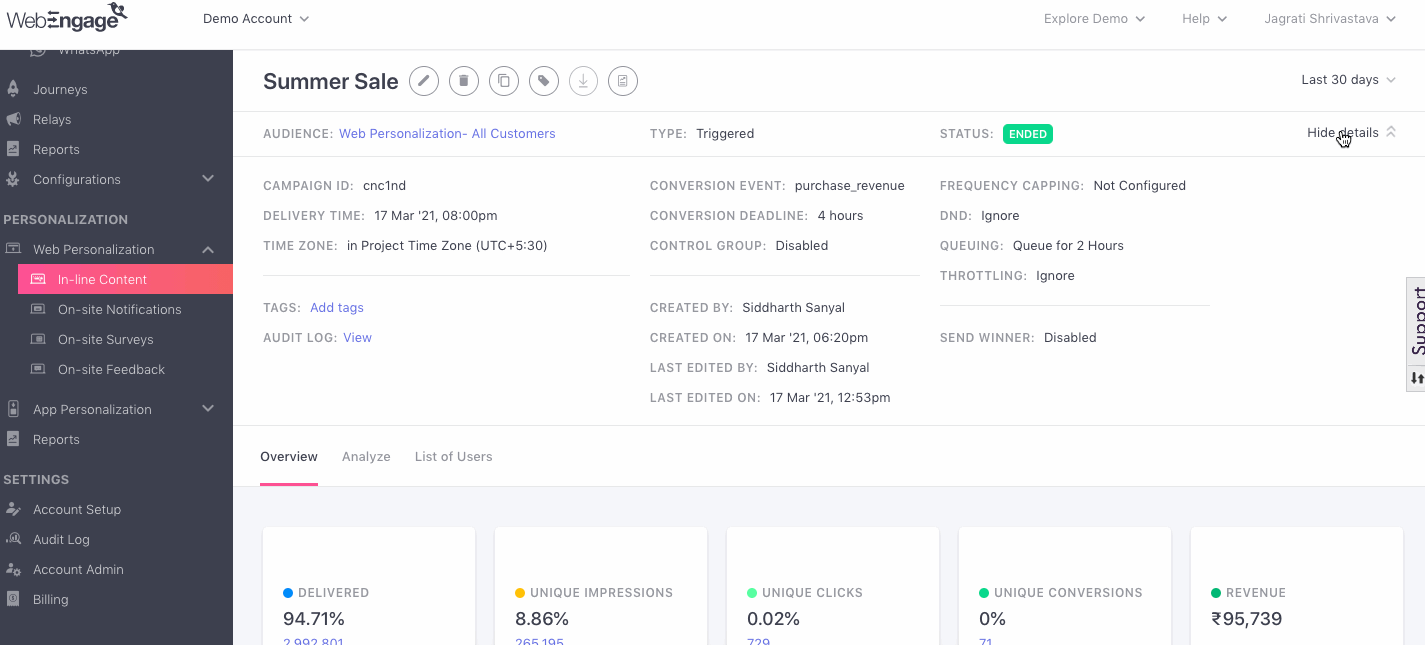
Click to enlarge
-
Audit Logs: Click View to access a history of all the interactions your account admins have had with the campaign. Each action, including campaign creation, message edits, and changes made to its settings is recorded here. (Detailed Read)
-
Conversion Event: Indicates the action users are expected to perform on your app after receiving the campaign, as specified at Step 4: Conversion Tracking, while creating it.
- If you have not set up Conversion Tracking for the campaign, then the same will be indicated by the status Disabled, here.
-
Conversion Deadline: Indicates the duration till which the campaigns' Conversion Event will be tracked after it has been delivered. The same can be specified at Step 4: Conversion Tracking while creating the campaign.
- If you have not set up Conversion Tracking for the campaign, then the same will be indicated by the status Disabled, here.
-
Control Group: Indicates whether or not a Control Group was set up to measure the campaign's effectiveness against organic user behavior at Step 4: Conversion Tracking, while creating it. The same is indicated by:
-
Enabled
-
Disabled
-
-
Send Winner: Indicates whether or not automated Variation testing was configured for the campaign while creating it, by setting up Send Winning Variation Automatically at Step 4: Conversion Tracking. The same is indicated by:
-
Enabled
-
Disabled
-
If Send Winner is enabled, then the following details will help you out with a quick recap of the rules of testing:
-
Size: Indicates the size of test audience with which all the _Variations _of the campaign will be tested with to determine a winning variant.
-
Time to Test: Indicates the duration for which all the Variations of the campaign will be tested for.
-
Win Criteria: Indicates the parameter (Impressions, Clicks, Conversions) based on which a winning Variation will be determined.
-
-
-
Created By: Indicates the name of the user who created the campaign.
-
Created On: Indicates the date-time on which the user started creating the campaign.
-
Last Edited By: Indicates the name of the user who has made the most recent edit to the campaign.
-
Last Edited On: Indicates the date-time on which the most recent edit was made to the campaign.
Now, let's show you how you can analyze a Web In-line Campaign to gain valuable insights into its impact on user engagement, conversions, and revenue.
How to Analyze
Must ReadPlease refer to Campaign and Channel Performance Indicators for a complete list of all the user-channel interactions tracked for Web In-line campaigns.
As shown above, using the navigation bar, you can toggle between the following sections to slice-and-dice data and analyze multiple aspects of the campaign:
Select a Time Frame of Analysis
Please Note: You Cannot Analyse 'List of Users' for a Specific DurationList of Users includes campaign engagement details for all the users that have been a part of the campaign's target audience throughout its lifetime.
By default, all stats under Overview and Analyze are shown from the campaign's Start Date till present day (if the campaign is running) or till upto 45 Days from the campaign's End Date (if the campaign has ended).

Click to enlarge
Using the date range filter, you can analyze the campaign's performance for the following durations:
Today
Yesterday
Last 30 Days
Last 90 Days
Custom Dates (as selected by you)
Now, let's dig into each section, starting with Overview.
Overview
Here you can analyze the campaign's performance from its Start Date till the present day (if the campaign is running) or till 45 days from the campaign's End Date (if the campaign has ended), against key performance indicators like Impressions Clicks, Conversions, Revenue for each Variation. You can alter this by selecting a time frame.
1. Performance Overview
This subsection presents a summary of the campaign against key performance indicators like Unique Impressions, Unique Closes, Unique Click, Unique Conversions, and Revenue.
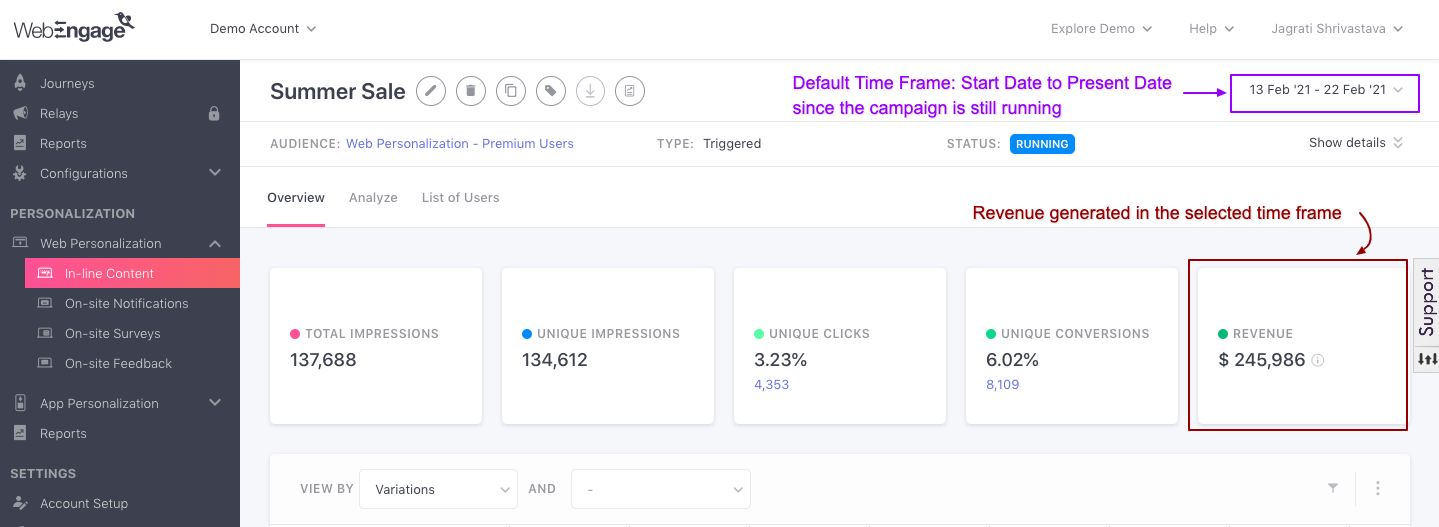
Click to enlarge
Let's go over each card:
Unique Impressions
Indicates the users that have seen the Web In-line Banner at least once within the selected time frame during a session.
Total Impressions
Indicates the total number of times users viewed the Web In-line Banner on the web browser within the selected time frame.
Unique Clicks
-
Unique Click Rate: Calculated against the number of Impressions it indicates the share of users that clicked on the Web In-line Banner within the selected time frame.
-
The card also indicates the number of users that clicked on theWeb In-line Banner helping you gauge the campaign's true impact on user engagement.
Unique Conversions
-
Unique Conversion Rate: Calculated against the total number of messages Delivered, it indicates the share of users that performed the campaign's Conversion Event at least once within the selected time frame.
-
The card also indicates the number of users converted through theWeb In-line Banner, helping you draw a fair comparison between the number of users who clicked on the campaigns, users who converted, and the total Revenue.
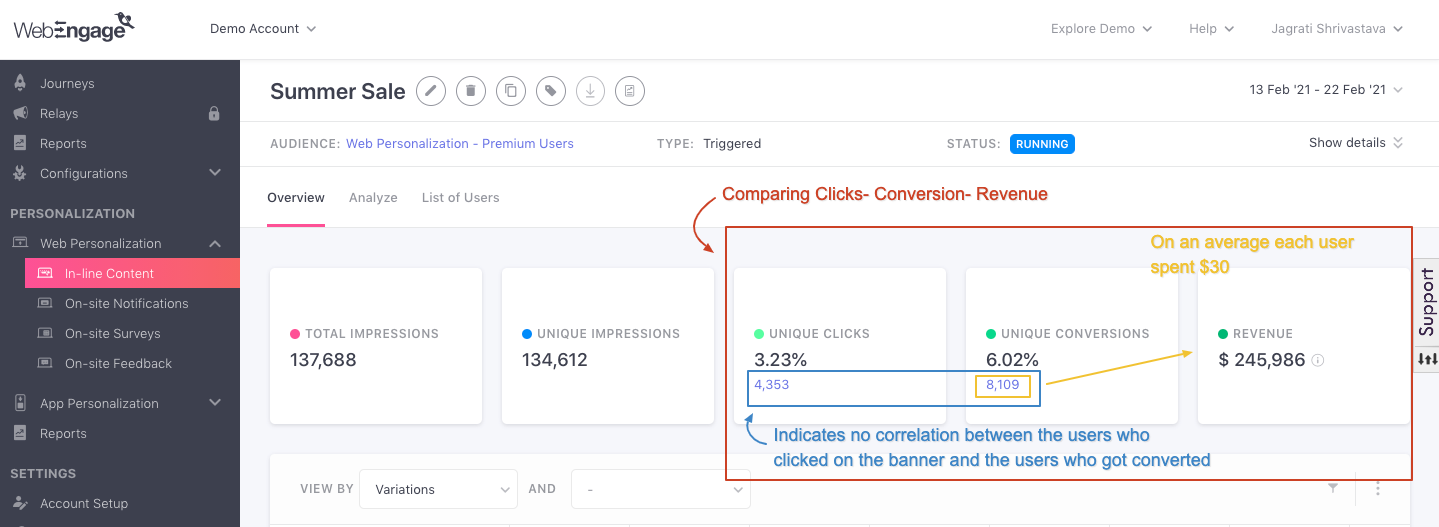
Click to enlarge
Comparing the number of Clicks - Conversions and Total Revenue of an Web In-line CampaignFor example, a quick look at the campaign's Performance Overview above reveals that contrary to the popular assumption, there is no correlation between the number of users who clicked on the banner (4,353) and those who made the purchase (8,109).
This is an extremely valuable insight as it could mean that most of these users had a high intent to purchase and would have booked the hotel stay irrespective of the offer.
The hypothesis can easily be tested by adding a Control Group to the campaign's target audience and comparing the conversion rate of the two groups (since control group users will not receive the campaign).
Please NoteConversions will not be tracked for your campaign if you have not specified a Conversion Event at Step 4: Conversion Tracking, while creating it.
- Compare Unique Conversions with Control Group: If you have enabled Control Group while creating the campaign, then as highlighted below, you will be able to draw a scientific comparison between the campaign's conversion rate and the organic conversion rate - helping you understand its true impact.
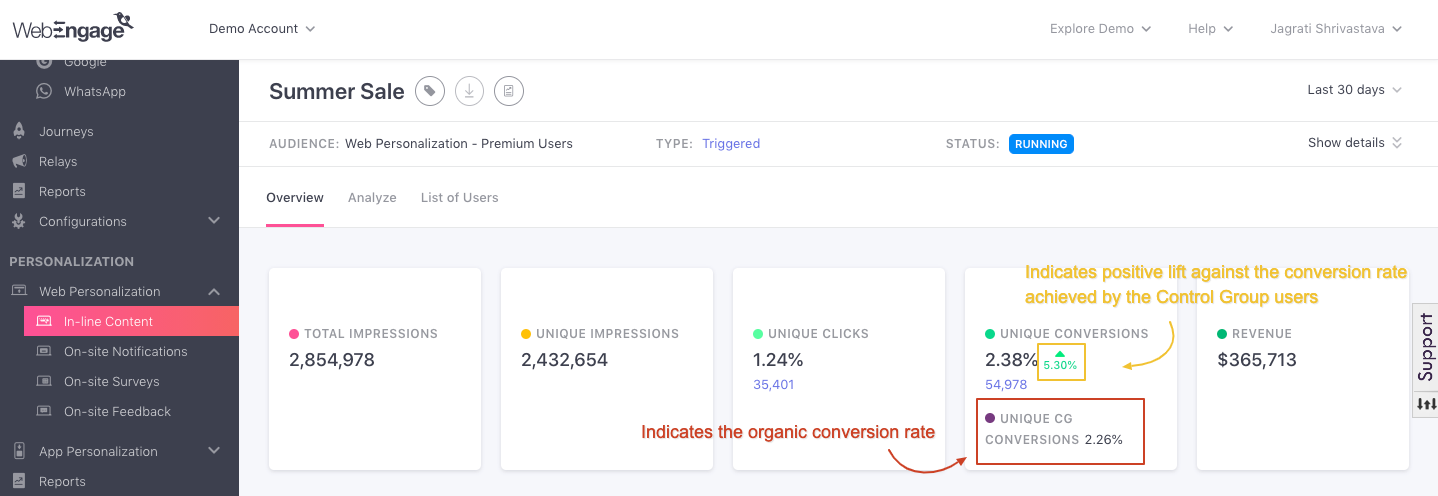
Click to enlarge
Analyzing Web In-line Campaign's Conversion Rate against Control GroupFor example, in the above visual, we have analyzed the conversion rate of a Web In-line campaign nudging users to search for summer clothing under the clothing section.
The campaigns Performance Overview reveals that:
Unique Conversion Rate of the campaign: 2.38%
Unique Conversion Rate of CG: 2.26%
Conversion Uplift: 5.30% (negative uplift is always indicated in red)
Clearly, the Web In-line campaign performed well but did not contribute majorly against the organic conversions.
Thus, it's always advisable to test your campaigns with a Control Group before sending it to the entire target audience to ensure that it helps amplify the desired user behavior, and not hinder it. Here's how you can automate Variation testing with a Control Group.
Now, let's walk you through the metrics shown here:
-
Unique CG Conversions: Calculated against the total number of users included in the Control Group (CG), it indicates the share of users that performed the campaign's Conversion Event at least once within the selected time frame, even though they didn't receive the campaign.
-
Conversion Uplift: Indicates the percentage increase or decrease in the Unique Conversion rate achieved by the campaign, calculated against the Unique Conversion rate of the Control Group.
- It's shown beside the campaign's Unique Conversion rate, in Green for positive uplift, in Red for negative uplift, and in Grey for no uplift.
Fact CheckConversion Uplift equals [(Unique Conversion Rate of Campaign/ Unique Conversion Rate of CG) x 100]- 100
Revenue
Indicates the amount of Revenue tracked for the Total Conversions that have occurred within the selected time frame.
- Revenue numbers are always shown in the currency selected by you while setting up Revenue Mapping
Please NoteRevenue will not be tracked for your campaign if:
You have not set up Revenue Mapping for your account
You have not specified a Conversion Event while creating the campaign
You have not mapped the specified Conversion Event as a Revenue Event in your account
Detailed Read on howRevenue tracking works and how Revenue is attributed to a campaign.
2. Variation Comparison
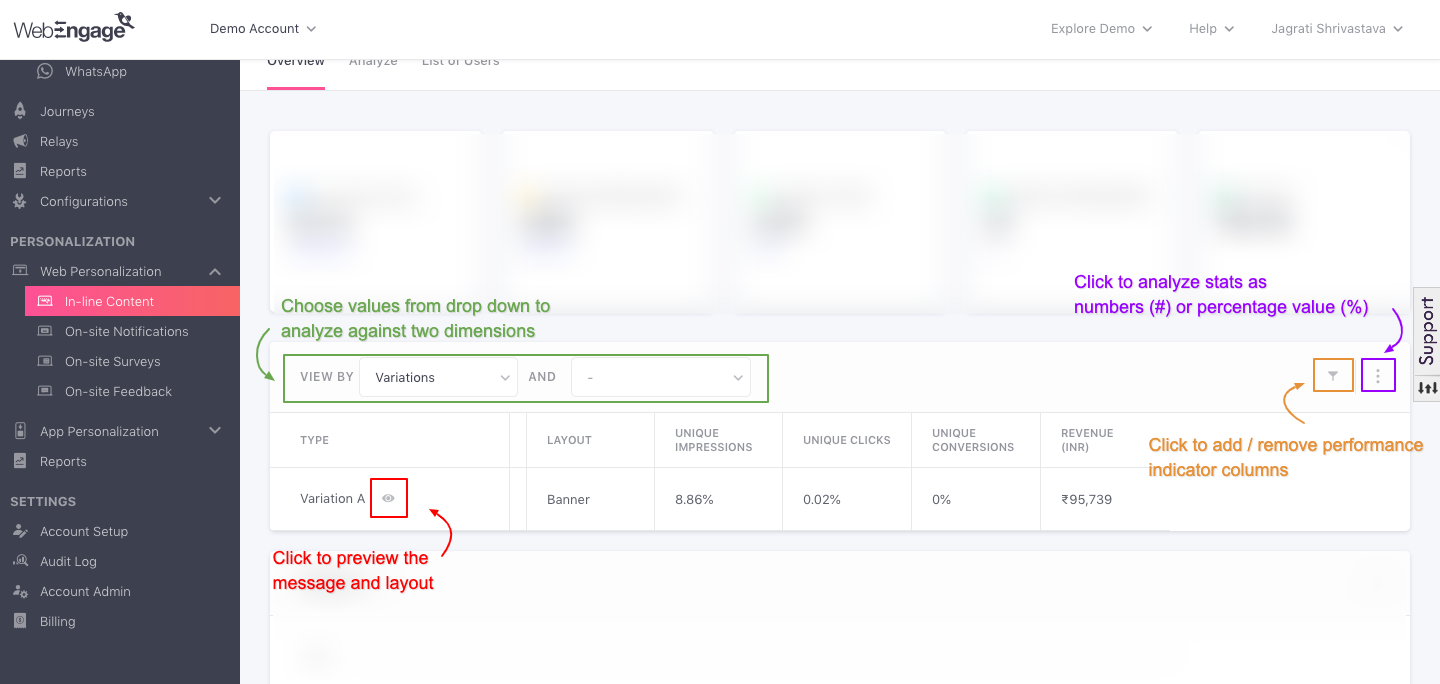
Click to enlarge
The most insightful section of Campaign Overview, Variation Comparison helps you analyze the impact of each message Variation against key metrics like their Layout (each Variation can have a different template), Dismisses, Clicks, Conversions, Revenue and so on, for the chosen time frame.
However, depending on the settings specified while creating the campaign, the stats shown here may vary. Let's get you acquainted with the impact of each:
Skip to: How to customize & analyze this section as per your strategic needs.
2.1. When Variation Distribution is Set Manually
If you have manually specified the audience size for all the Variations at Step 4: Conversion Tracking, then using this section, you will be able to identify a winning Variation by analyzing the performance of each. The following aspects of the test will be highlighted here:
-
Percentage of the audience targeted by each Variation (calculated against the total target audience)
-
The performance of each Variation against all the performance indicators tracked for Web In-line campaigns.
Let's demonstrate a short use-case to show you how it works:
Analyzing Manual Variation Distribution Test ResultsLet's take the example of an e-commerce app. In the visual below, we have analyzed the performance of a Web In-line campaign offering free shipping to all users who have added products to their cart but have not completed checkout yet.
Marketers of the app wanted to compare the effectiveness of different variations in the message on the banner and thus, created three versions of the campaign.
Both variations consisted of the same message and were equally divided amongst the target audience.
End Goal: Identify which message style leads to higher conversions
Key takeaways:
- Variation C emerges as the winner as it resulted in maximum Unique Conversions - 6.08%, contributing $ 295,435 in Revenue! While Variation A achieved a Unique Conversion rate of 5.4%, contributing $1,7,896 in Revenue and Variation B achieved a Unique Conversion rate of 4.84%, contributing $166,476 in Revenue.
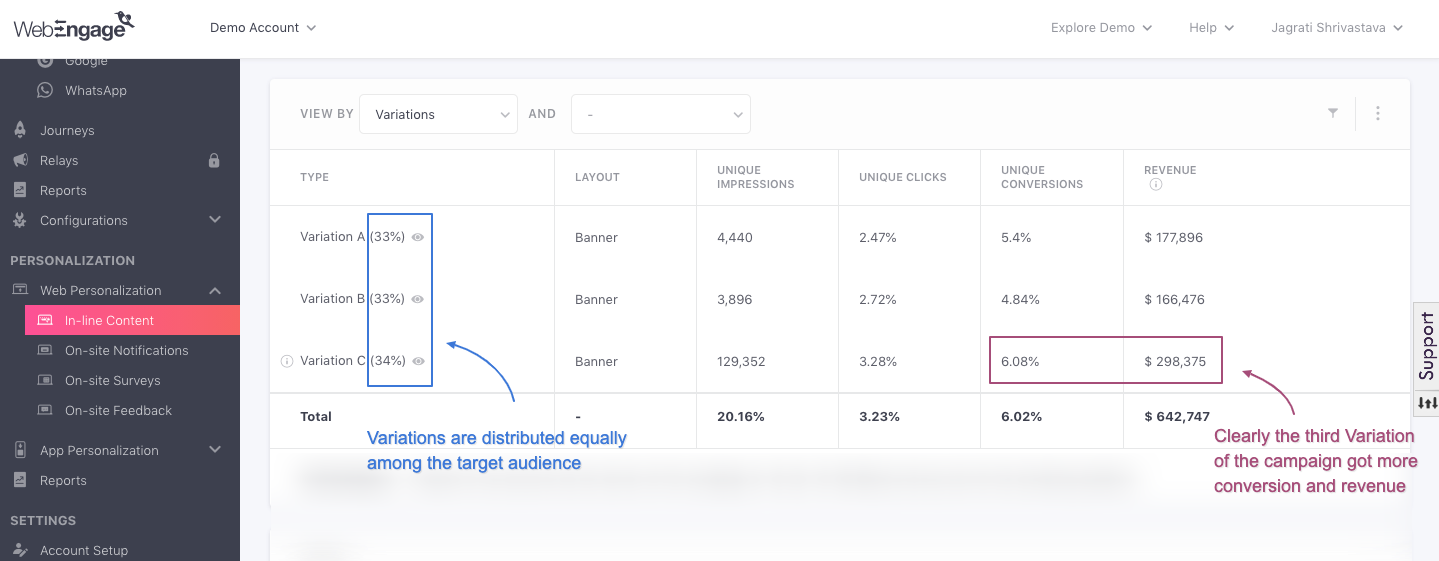
Click to enlarge
Skip to: How to customize and analyze this section as per your strategic needs.
2.2. When Send Winning Variation is Enabled
If you have enabled Send Winning Variation Automatically at Step 4: Conversion Tracking while creating the campaign, then you will be able to analyze the test results through this section. As shown below, the following aspects of the test will be highlighted here:
-
The winning variation (which was automatically sent as the only campaign to the entire target audience)
-
The performance of each Variation that was tested with the test audience.
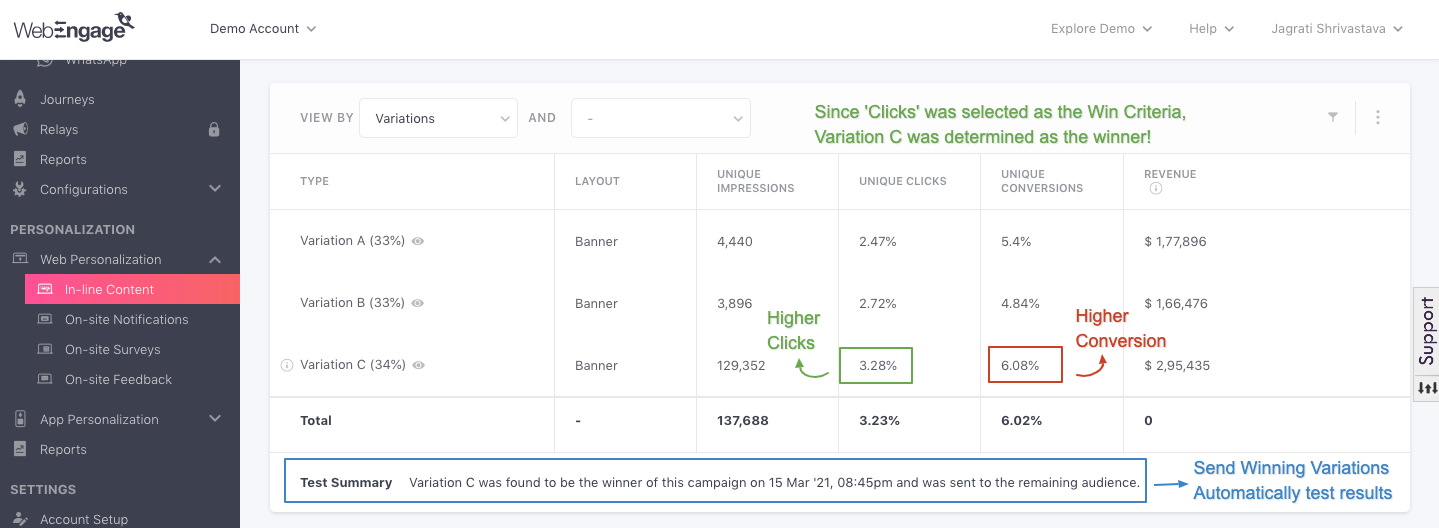
Click to enlarge
For example, in the above visual, we can see that Variation C (6.08%) achieved a higher Unique Conversion rate and was determined the winner.
This is because Clicks was selected as the Win Criteria of the test while setting it up, and Variation C (3.28%) achieved a higher Unique Click Rate_than _Variation A (2.47%). and Variation B (2.72%). Similarly, you too can select a custom Win Criteria for testing the Variations, as per your business goals.
Skip to: How to customize and analyze this section as per your strategic needs.
2.3. When Control Group is Enabled
If you enabled Universal Control Group or added a custom/campaign control group while creating the campaign, you can compare the performance of your campaign against each Variation created. You can compare each Variation's conversion rate with the Control Group's organic conversion rate to determine its true impact on driving conversions. This can be done by enabling Control Group at Step 4: Conversion Tracking while creating the campaign.
As shown below, the extent to which a Variation influences users to perform the Conversion Event can be measured through its Conversion Uplift, indicated alongside Total Conversions and Unique Conversions, in Green, for positive uplift, in Red, for negative uplift and in Grey for no uplift.
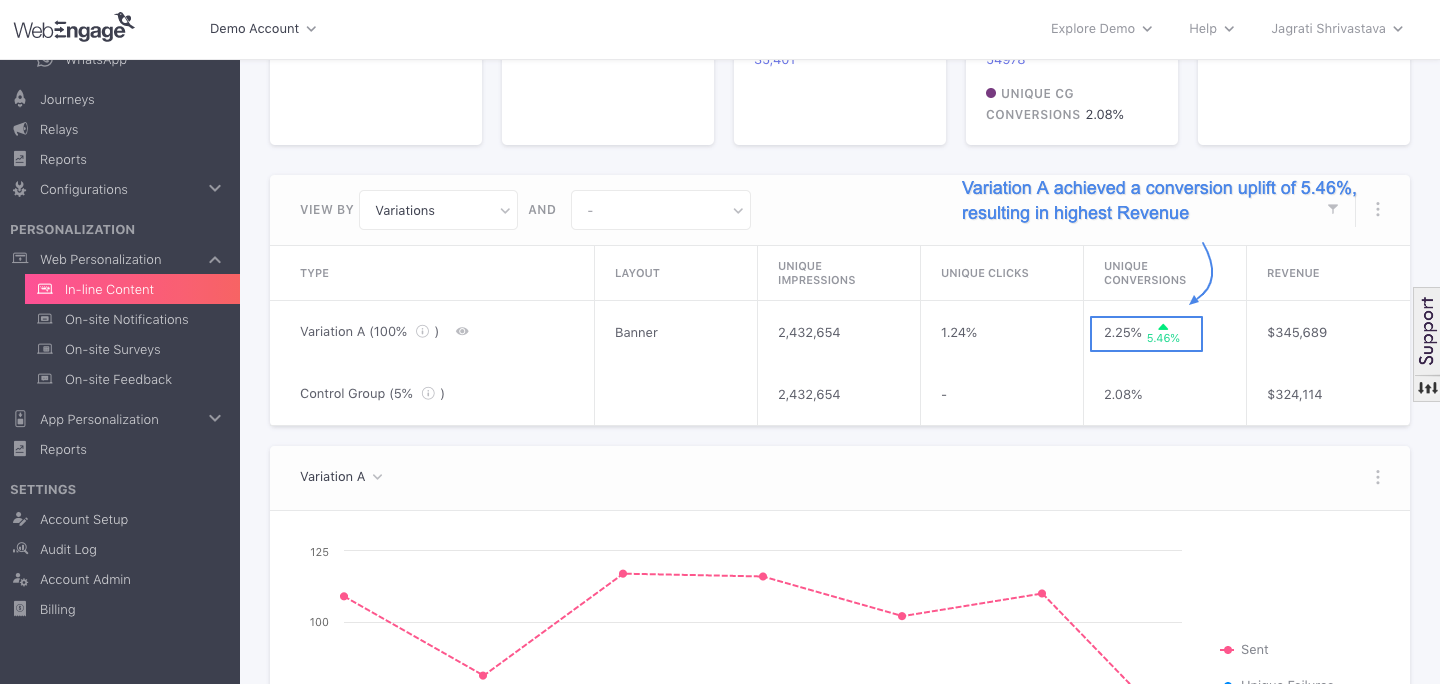
Click to enlarge
Analyzing Variations Against Control Group through Conversion UpliftIn the above visual, we have analyzed 1 Variation of a Web In-line campaign and a Control Group against Unique Impressions, Unique Clicks, Unique Conversions and Revenue.
- Since Control Group was enabled for the campaign, Unique Conversion rate was the sole Win Criteria used to identify a winner version of the message.
On comparing theVariation against the Control Group we learn that:
Users who did not receive the campaign as a part of the Control Group converted at a rate of 2.08%, contributing $324,114 in Revenue.
Variation A influenced the maximum number of users to convert, achieving a Conversion Uplift of 2.25% and contributing a whopping $345,689 in Revenue!
- As a result, Variation A was identified as the winner and was sent to the entire target audience of the campaign (indicated by the test results highlighted above).
Related Reads
Why you should (almost) always use a Control Group to measure the effectiveness of your campaign and how it works.
How you can test Variations with a smaller test audience and automatically send the winner to the entire target audience of the campaign!
Now, let's show you how you can slice-and-dice this section to gain relevant insights:
Step 1: Customize Table

Click to enlarge
By adding values to the query bar highlighted above, you can choose to analyze Variations split by the Browser, Device Type, and OS or vice-versa, against all the performance indicators tracked for Web In-line campaigns.
In doing so, you will be shown a secondary view of each Variation, split by the selected option, helping you analyze user-campaign interactions in further detail, as shown below.
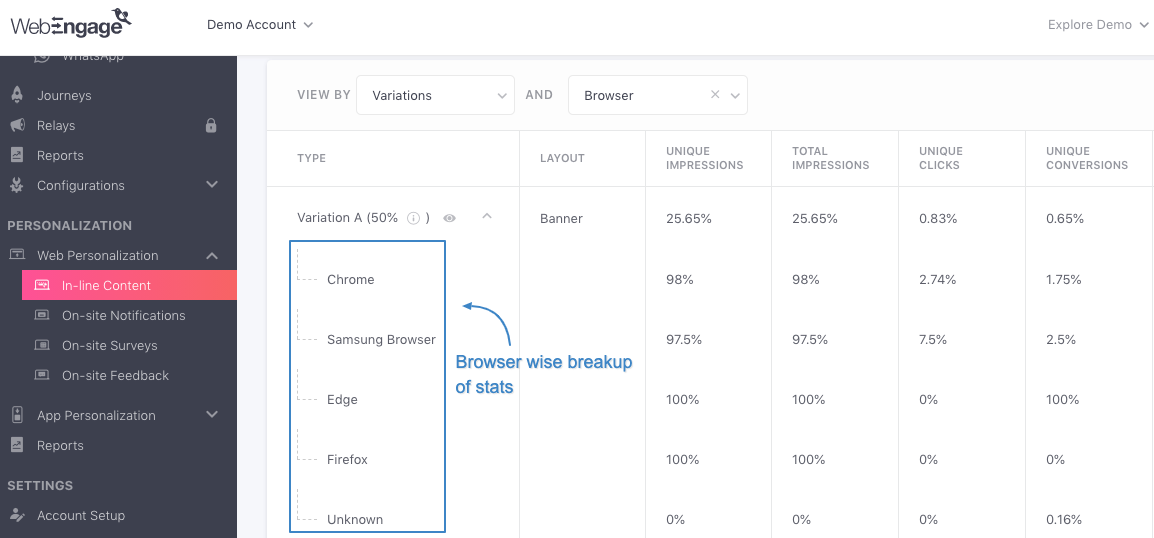
Click to enlarge
The following options can be selected under both the fields:Variations: Helps you compare the performance of all the Variations for the selected time frame.
Technology
OS (iOS, Android)
Browser (Chrome, Edge, Opera, Firefox, Safari, and so on)
Device Type (Mobile, Desktop)
Step 1: Select Performance Indicators
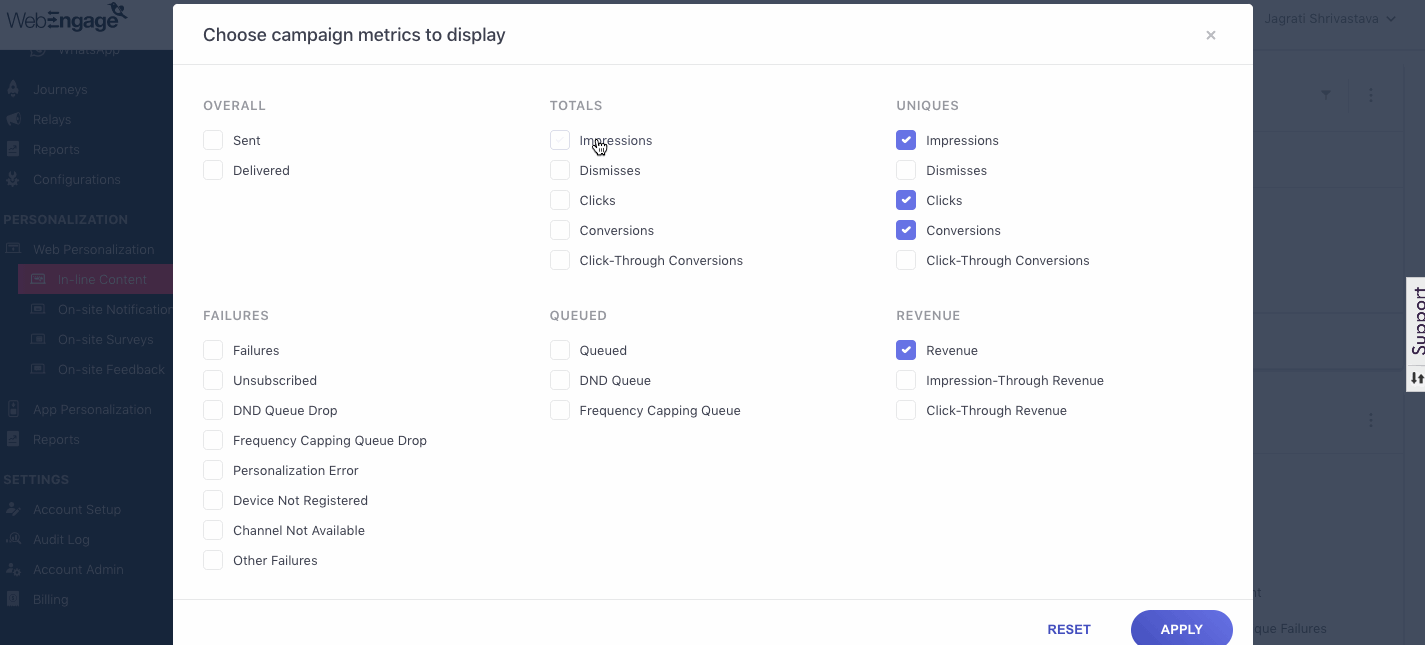
Click to enlarge
As shown above, using the filter icon placed on the top right, you can select/deselect metrics to customize the table as per your analytical needs.
The following metrics can be selected here:Totals (Total Impressions, Total Closes, Total Clicks,Total Conversions, Total Click-through Conversions)
Uniques: (Unique Impressions, Unique Closes, Unique Clicks, Unique Conversions,Unique Click-through Conversions)
Revenue (Total Revenue,Click-through Revenue)
Step 3: Preview Variation's Message & Layout

Click to enlarge
As shown above, using the View icon_placed next to each _Variation's header, you can preview the Web In-line Banner for both, Desktop and Mobile users. This is a great way to understand how varied copies and layouts impact user-campaign interactions.
Step 4: Select a Data Format

Click to enlarge
While the default view shows you percentage values (%) for all the campaign performance indicators, using the overflow menu highlighted above, you can choose to analyze these stats as numbers (by selecting #).
- Percentage value of all the performance indicators like Closes, Clicks, Conversions and Click-through Conversions is calculated against the total number of Impressions.*
3. Engagement Trends
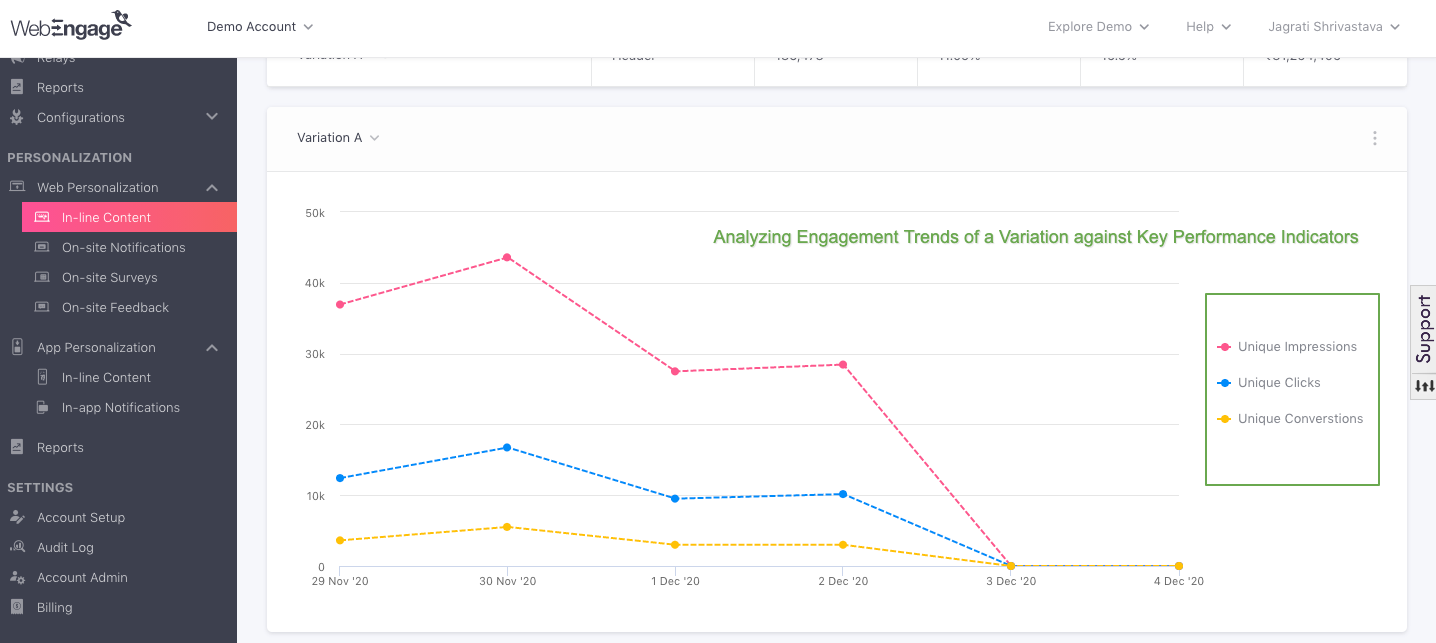
Click to enlarge
This section helps you analyze day-wise user engagement trends for each Variation against the following performance indicators, as per the chosen time frame.:
- Unique Impressions
- Unique Clicks
- Unique Conversions
Let's analyze a use-case to get you acquainted with the workings of this section:
Skip to: How you can customize the stats shown here as per your analytical needs.
Use-case: Analyzing Engagement Trends for a Cart Recovery CampaignIn the visual below, we have analyzed the engagement trends of a Journey Web In-line campaign for the last 7 days (Nov 28 - Dec 21) as a Funnel View.
About the campaign:
The campaign aims at driving purchases for an e-commerce app by offering free shipping to all users who have searched for a product but have not purchased it even after 30 minutes. It's triggered for all users who perform the custom event - Product-Searched, after a Wait Time of 30 minutes if the user has not performed the custom event - Checkout-Complete.
The Conversion Event is also set as Checkout-Complete with a Conversion Deadline of 2 Days.
The campaign was launched on November 28.
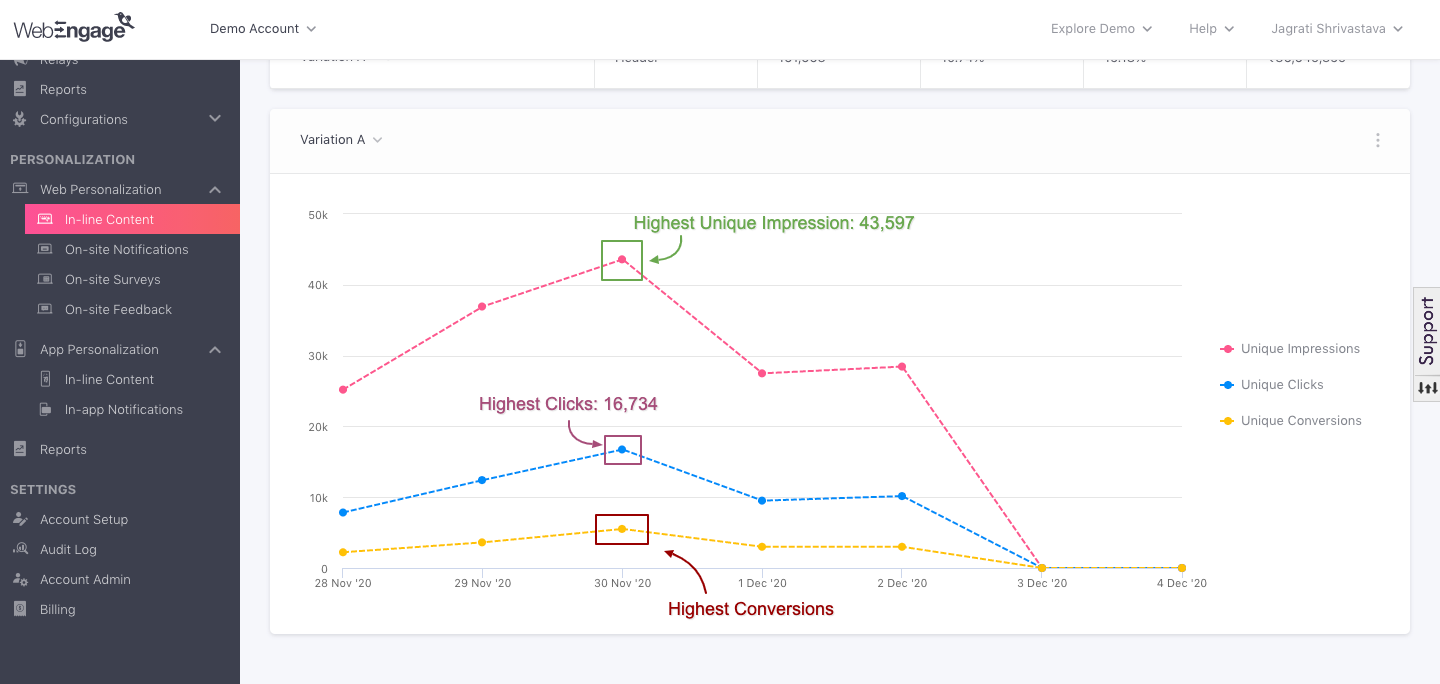
Click to enlarge
On analyzing engagement trends, we learn that:
-
The highest number of Unique Impressions, 43,597 and Unique Conversions, 5,518 occurred on Nov 30.
-
Interestingly, the engagement trends suggest that most of the users who performed the campaign's Conversion Event - Checkout Complete, did not actually click on the notification. They simply viewed it and converted.
- Such conversions are tracked as Impression-through Conversions in your dashboard and can be further analyzed through a campaign's Analyze section.
Now, let's widen the scope of analysis to a month (Oct 13 - Nov 13) to gain a better perspective on the campaign's engagement trends.
It reveals that:
-
The highest Unique Impressions occurred on Nov 2, 600, followed by Oct 20, 556.
-
The Unique Conversion and Unique Click trends throughout the month suggest that there is no correlation between the clicks and conversions contrary to popular assumption. Even though a low number of users clicked on the campaign, the conversion numbers consistently remain high.
-
Further, the highest Unique Conversions also occurred on _Nov 2, 326._suggesting that users targeted by the campaign on this day had a higher intent to convert compared to other users.
We hope this has equipped you with a robust understanding of how you can leverage Engagement Trends to gain valuable insights into user behavior and the campaign's overall performance.
Now, let's show you how you can customize this section as per your analytical needs:
Step 1: Select a Variation
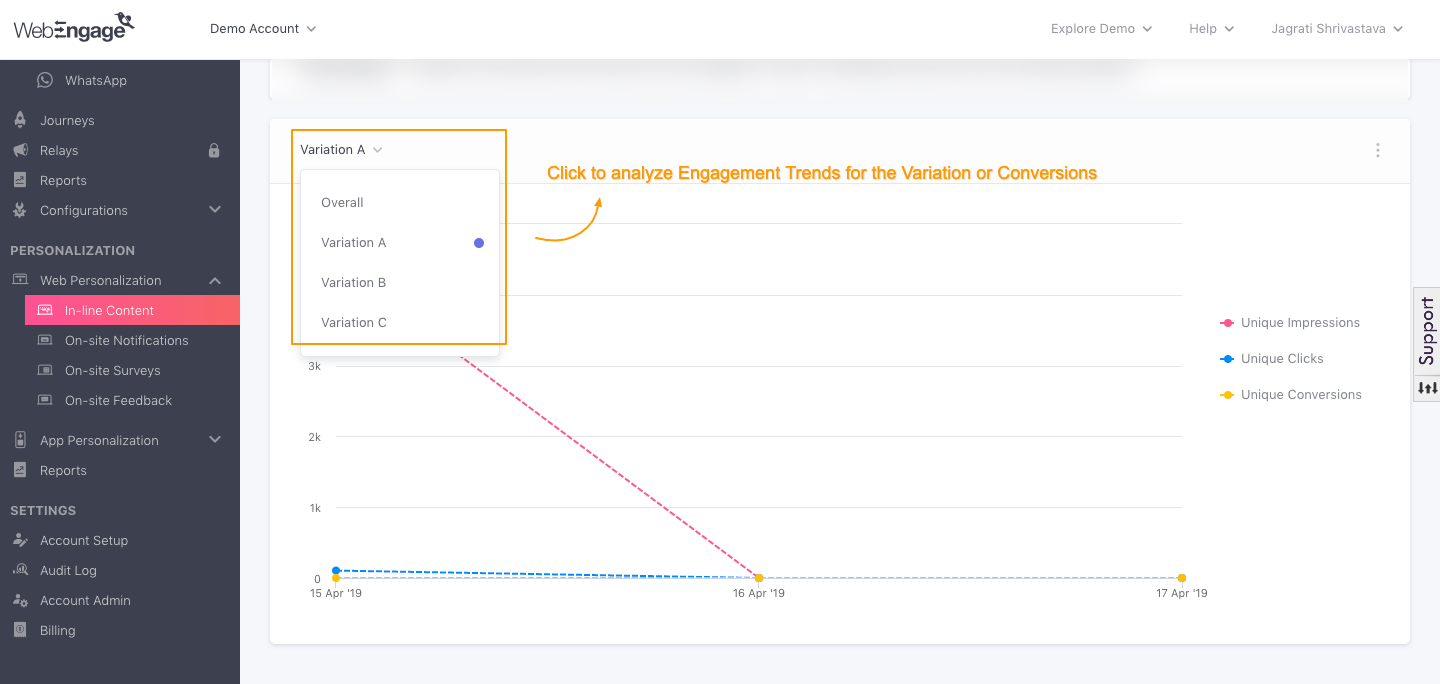
Click to enlarge
By default, engagement trends are shown only for Variation A (the first version of the campaign). Using the dropdown placed on the top left, you can choose to analyze trends for each Variation against - Unique Impressions, Unique Closes, Unique Clicks and Unique Conversions.
- If you have enabled Control Group for the campaign, then you can choose to analyze its Unique Conversion trends by selecting 'Control Group' from the dropdown highlighted above.
Step 2: Select a Format of Visualization
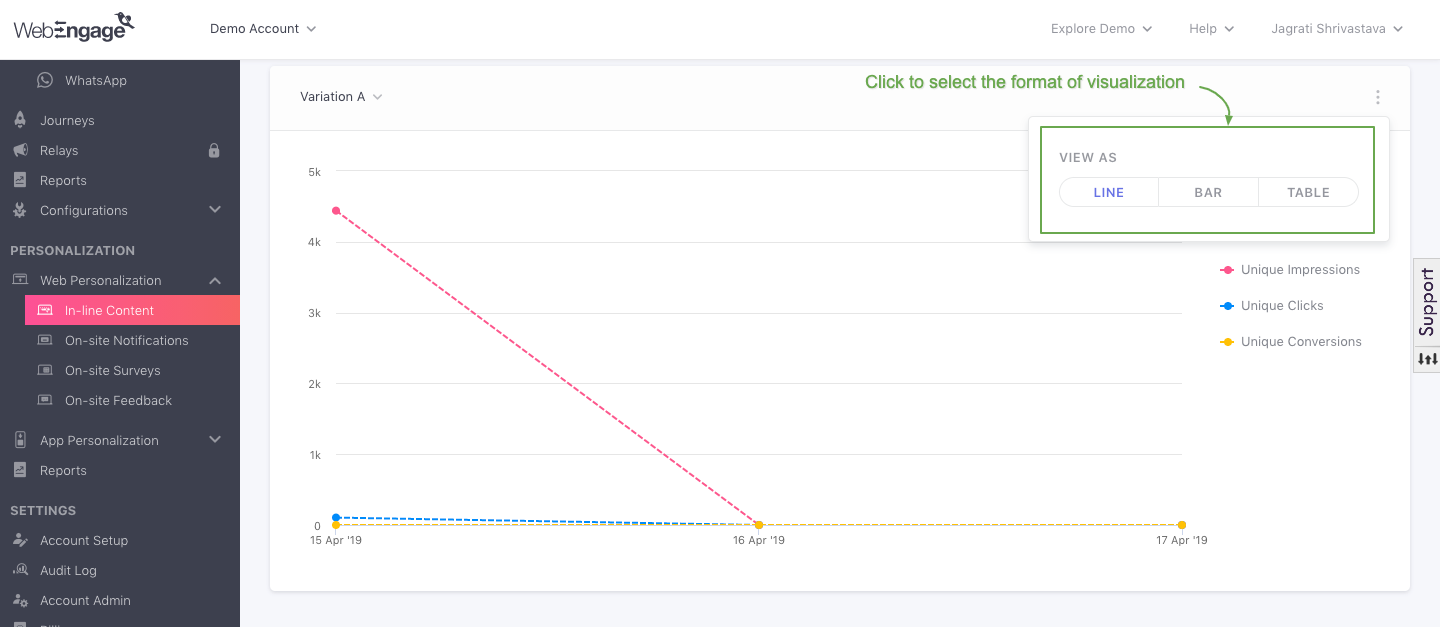
Click to enlarge
While the default format of visualization is a Line Graph, as shown above, using the overflow menu placed on the top right, you can change this to a Bar Graph or a Table, as per your analytical needs.
Analyze
While Overview presents a comprehensive view of the campaign's performance, this section helps you slice-and-dice data in multiple ways to gain maximum insights into user-campaign interactions.
First Impression
The default view of this section shows you a Day-wise trend for Total Impressions recorded for all the Variations from the campaign's Start Date till the present date or till up to 45 days from its End Date (whichever occurs first).
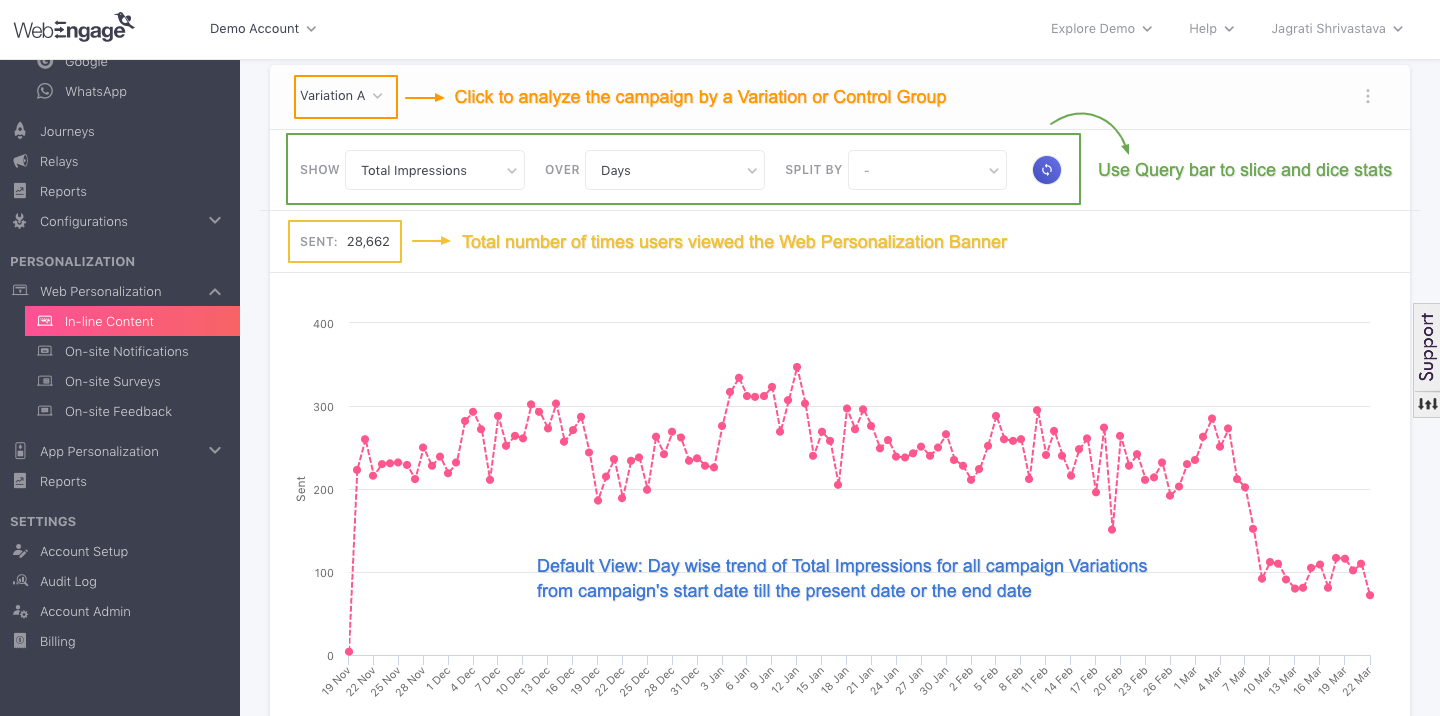
Click to enlarge
Using the query bar highlighted above, you can choose to analyze the campaign's performance against a specific performance indicator, split by 2 parameters for a custom time frame.
Let's Analyze a Use-case to Show You How it Works
Skip to: How you can customize the stats shown here as per your analytical needs.
Use-case: Analyzing a Web In-line Campaign Nudging Users to Search for University Enterance Exam Practice Material After University SearchLet's take the example of an international Edtech website. They recently launched university entrance exam study material as a new feature, and in a bid to drive adoption, they decided to contextually nudge users to try it out.
Marketers of the website created a campaign that nudges all users who have searched for universities to search for a university entrance exam material.
The end goal was to drive adoption and not necessarily purchase (as an outcome of great product adoption). Hence, the campaign's Conversion Event was set as the custom event, University-Search.
Now, let's analyze the campaign to understand it's users and their behavior better.
Analysis 1 (in continuation of the use-case)Identifying the top countries and type of users who searched for universities entrance exam material after searching for universities, over the last 30 days. For this, we'll analyze Total Impressions over Countries, split by User Type.*
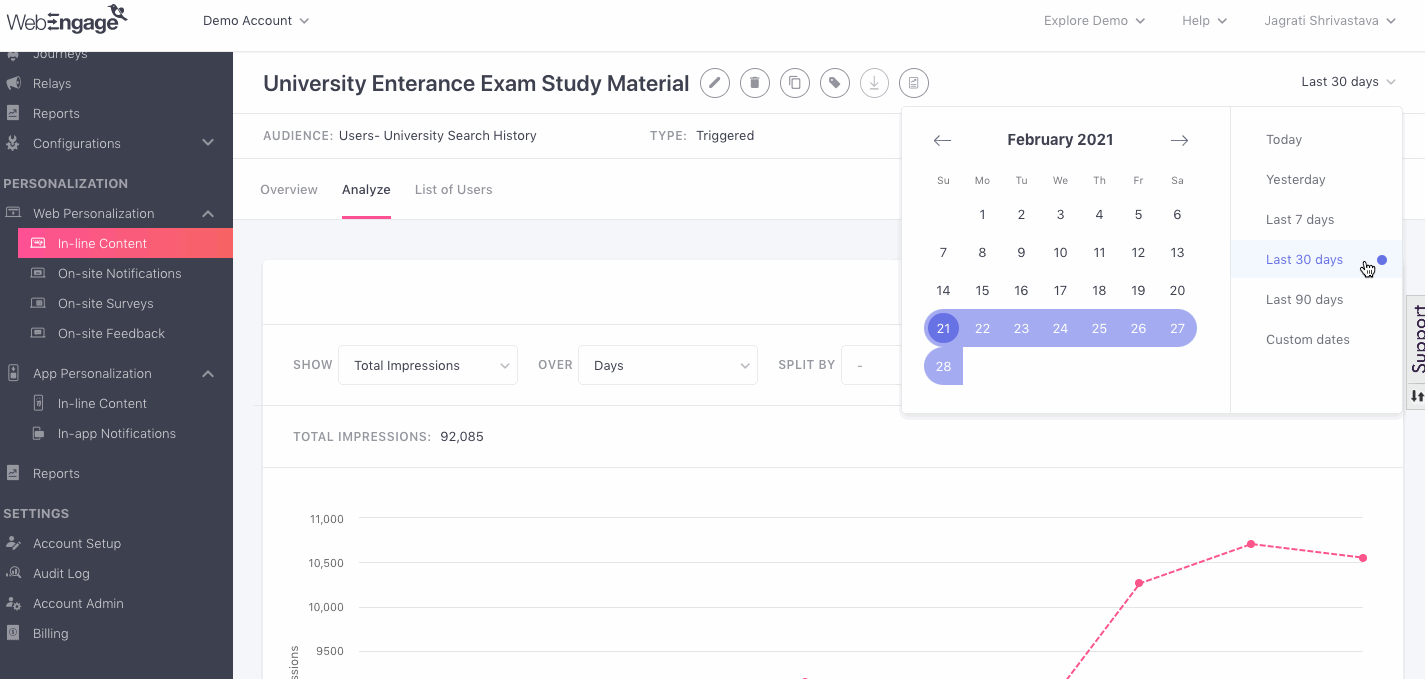
Click to enlarge
As shown above, here's how they went about their analysis:
Step 1: Since the campaign was launched in past, we'll select Last 30 days as the time frame of analysis.
Step 2: Select Country under the field - Over.
Step 3: Select User Type under the field - Split By and click enter!
It reveals that:
-
The notification was viewed 91,896 times within the selected time frame.
-
The maximum number of users engaged through the Web In-line Banner are located in India, out of which The highest number of Impressions were recorded for *Known Users, 79,913.
Analysis 2 (in continuation of analysis 1 of the use-case)Now, let's analyze users who performed the conversion event of the campaign (Total Conversions), against the same variables, User Type and Country. This will help us draw a fair comparison between the users who viewed the notification and those who converted.
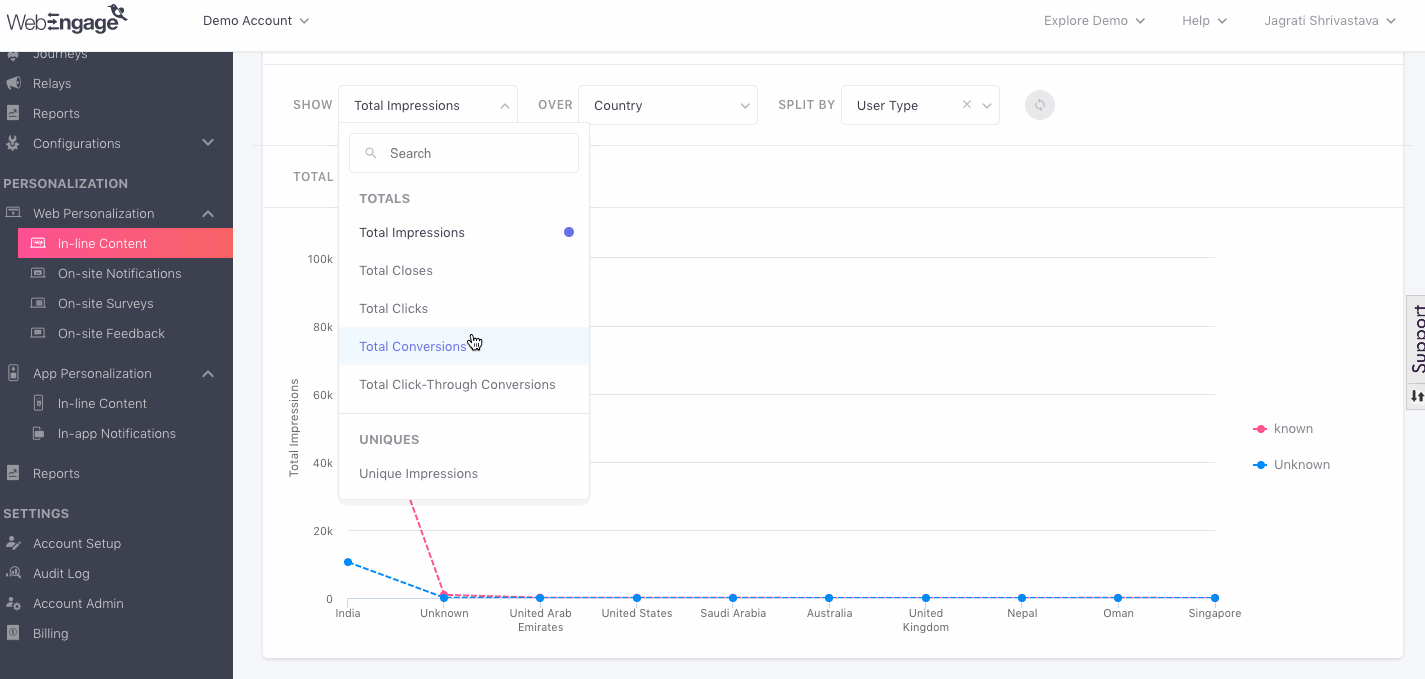
Click to enlarge
As shown above, we'll select Total Conversions under the field - Show and click enter.
It reveals that:
-
Users engaged through the notification performed the campaign's Conversion Event - Hotel-search a total of 6,048 times within the selected time frame.
-
Keeping up with the Total Impression trends, the maximum number of converted users are located in India and are Known.
Analysis 3 (in continuation of analysis 2 of the use-case)Now that we have a fair idea of the campaign's impression and conversion trends, let's dig into the time of the day and country where the users interact with the website. For this, we'll analyze Total Conversions over Hours of the Day, split by Country.
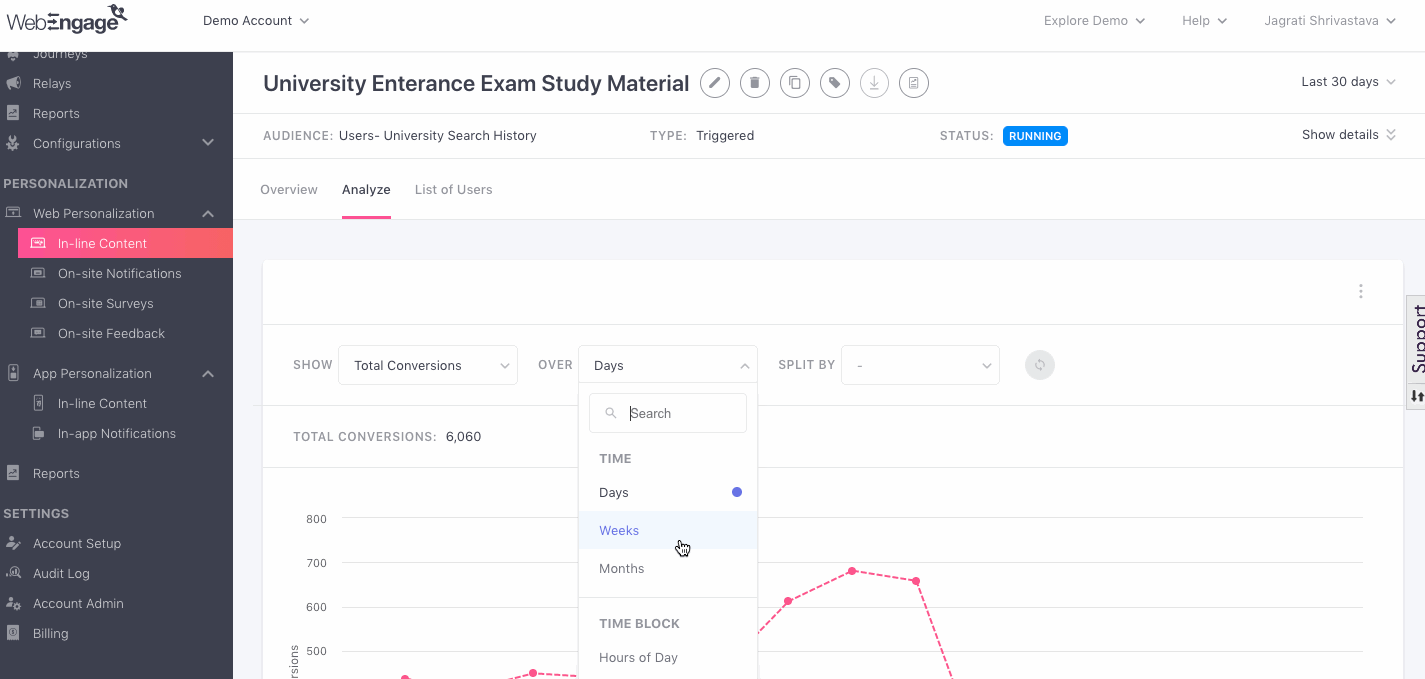
Click to enlarge
As shown above, here's how they went about their analysis:
Step 1: Select Hours of the Day under the field - Over.
Step 2: Select Country under the field - Split By and click enter!
It reveals that:
-
Maximum users engaged by the Web In-line are from India India.
-
The highest Conversions occurred between 11 pm - 12 am (as per the account's timezone), followed by a spike in Conversions between 12 am pm - 1 am. This indicates that most users prefer to engage with the app during late-night as they unwind from a tiring day.
We hope this has equipped you with a broad understanding of how you can gain in-depth insights into your campaign, its users, and their preferences through Analyze. Now, let's walk you through all the steps of analysis:
Step 1: Select a Variation/ Control Group
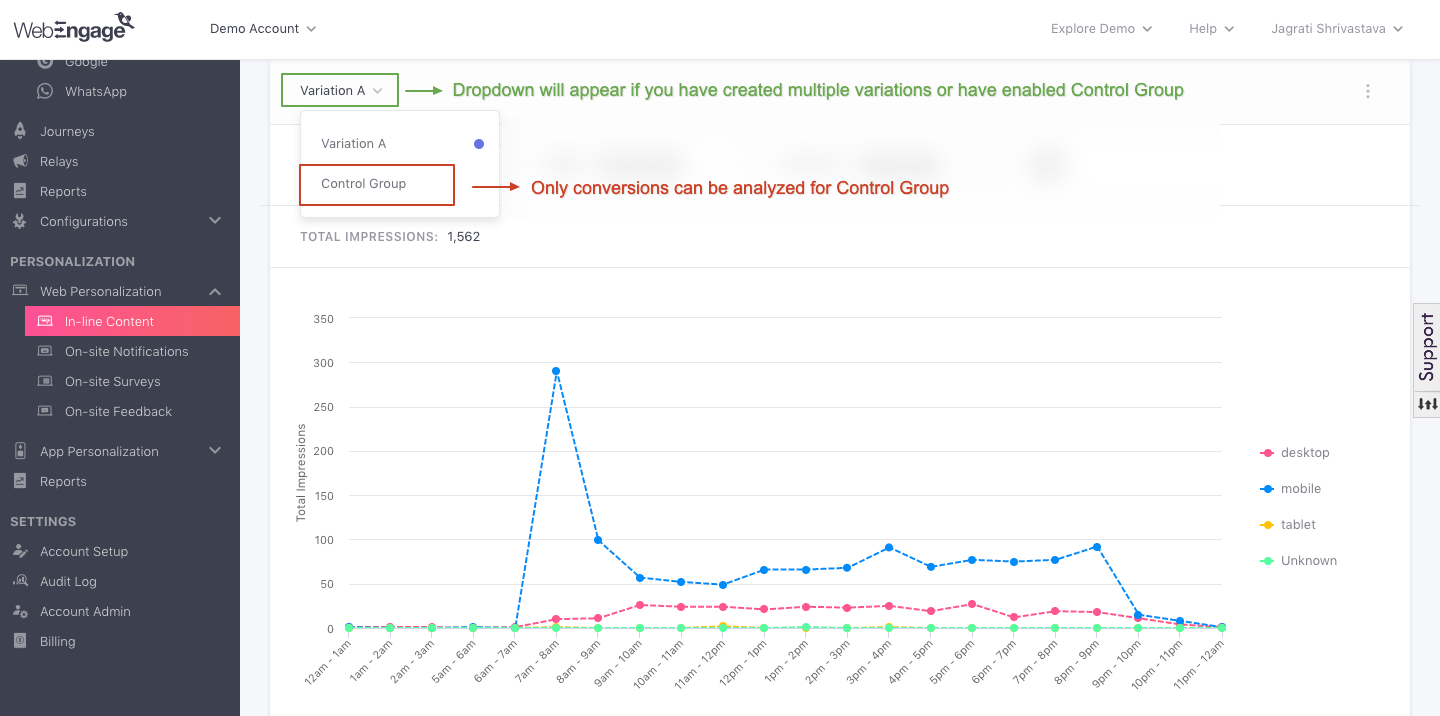
Click to enlarge
If you have created multiple Variations for a Web In-line campaign, or have enabled Control Group for it, then using the dropdown highlighted above; you can choose to selectively analyze the performance of each.
However, if your campaign consists of just one Variation, then this dropdown gets hidden.
Any one of the following options can be selected here:
Overall: Helps you analyze the combined performance of all the Variations against each metric for the selected time frame.
- For example, if you choose to analyze Revenue, Overall, then we will sum up the Revenue tracked for each Variation to help you analyze their collective impact.
Variation A/B/C/D/E: Helps you analyze the performance of a Variation, against a selected performance indicator, as per the chosen time frame.
Control Group: If you have enabled Control Group at Step 4: Conversion Tracking while creating the campaign, then selecting this option will help you its Unique Conversions/ Total Conversions.
Related ReadPlease refer to Campaign Variations and Testing for a quick read on how you can test multiple Variations of a campaign with a smaller audience and automatically send the winner to the entire target audience!
Step 2: Select a Performance Indicator
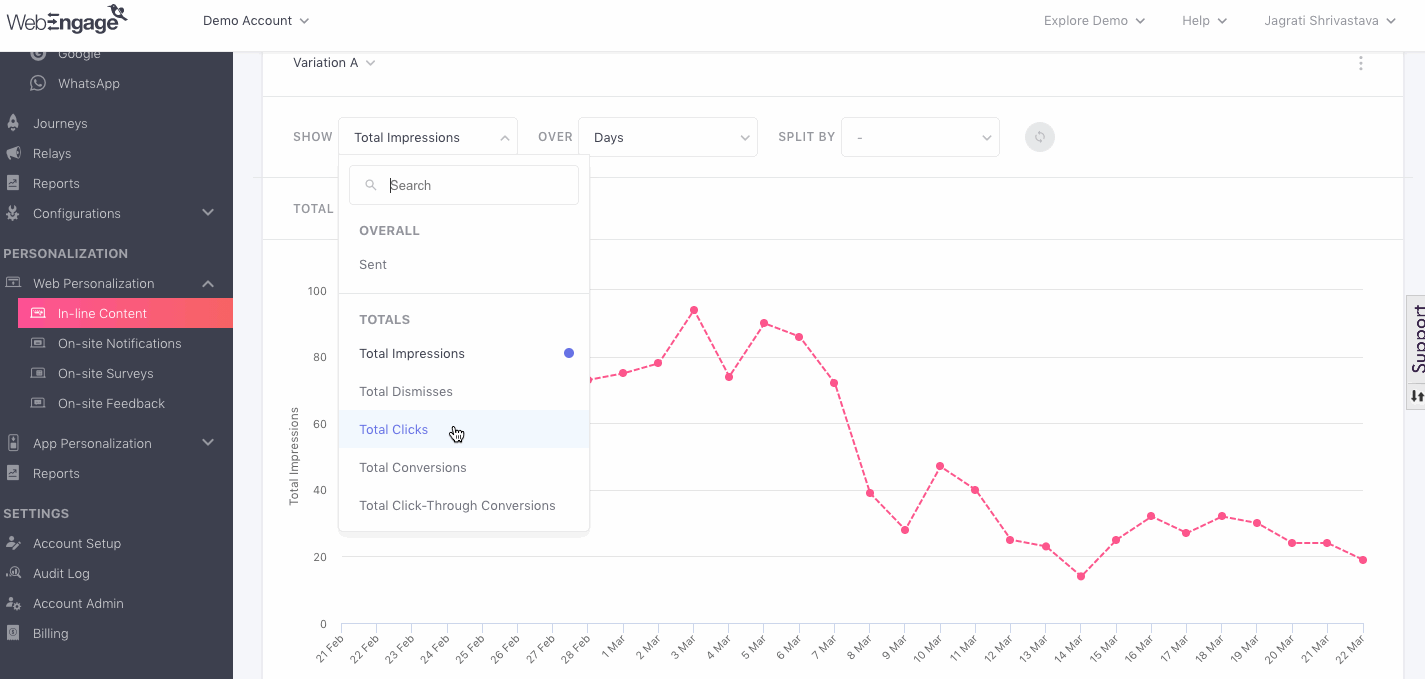
Click to enlarge
You can choose to analyze the overall performance of the campaign or each Variation against a performance indicator or campaign event (like Impressions, Clicks, Conversions, Revenue) by selecting an option under the field - Show.
- As highlighted above, the total value of the selected performance indicator is also indicated under the query bar.
Any one of the following campaign events can be selected here:
Totals (Total Impressions, Total Closes, Total Clicks,Total Conversions, Total Click-through Conversions)
Uniques: (Unique Impressions, Unique Closes, Unique Clicks, Unique Conversions,Unique Click-through Conversions)
Revenue (Total Revenue,Click-through Revenue)
Step 3: Select the Dimension(s) for Analysis (Over & Split By)
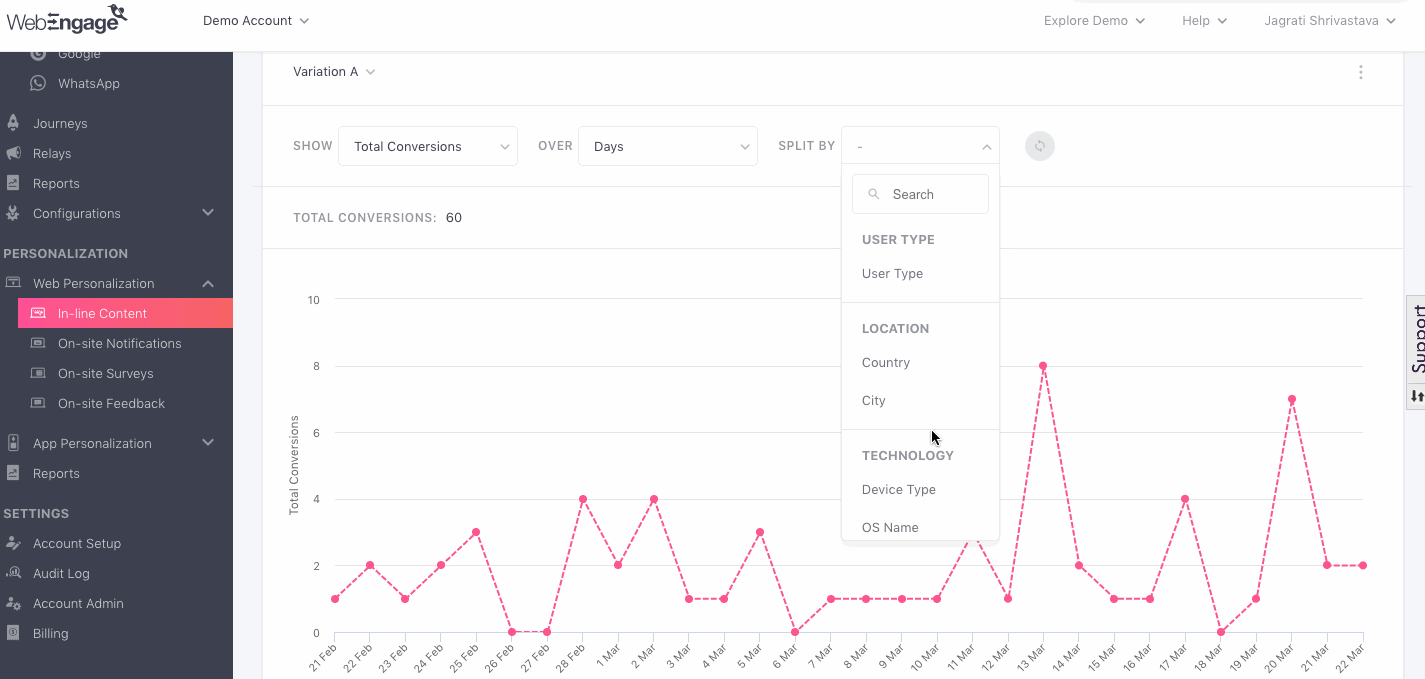
Click to enlarge
As demonstrated for the use-case discussed above, by selecting an option under the fields - Over and Split By, you can choose to analyze the selected performance indicator (campaign event) against two dimensions (system attributes). This is a great way to dig into multiple aspects of the campaign like:
-
The top Locations and Devices used to perform the selected campaign event
-
The Types of Users who performed the campaign event and their Browser preferences
-
The trend of occurrence of selected campaign event against Hours of the Day, Days of the Week, or Months of the Year and so on.
The following options can be selected under both the fields:
Time (Days, Weeks, Months)
Time Block: Trends against time, Hours of Day, Days of Week, Months of Year, are always shown in your project's timezone, as set by you while setting up your WebEngage account.
User Type (What it means)
Location (Country, City)
Technology (Device Type, OS Name, Device Manufacturer, Device Model, App Version, App ID, Platform)
List of Users
Must ReadPlease ensure that you have a good understanding of the various types of Users and related concepts before proceeding. Doing so will help you understand the workings of this section, better.
This section has been specially designed to help you track down campaign engagement details for each user targeted by the campaign over its entire lifetime.
By default, List of Users shown you a Summary of user-campaign interactions for All Users who have been included in the campaign's target audience, from its Start Date till the present date.
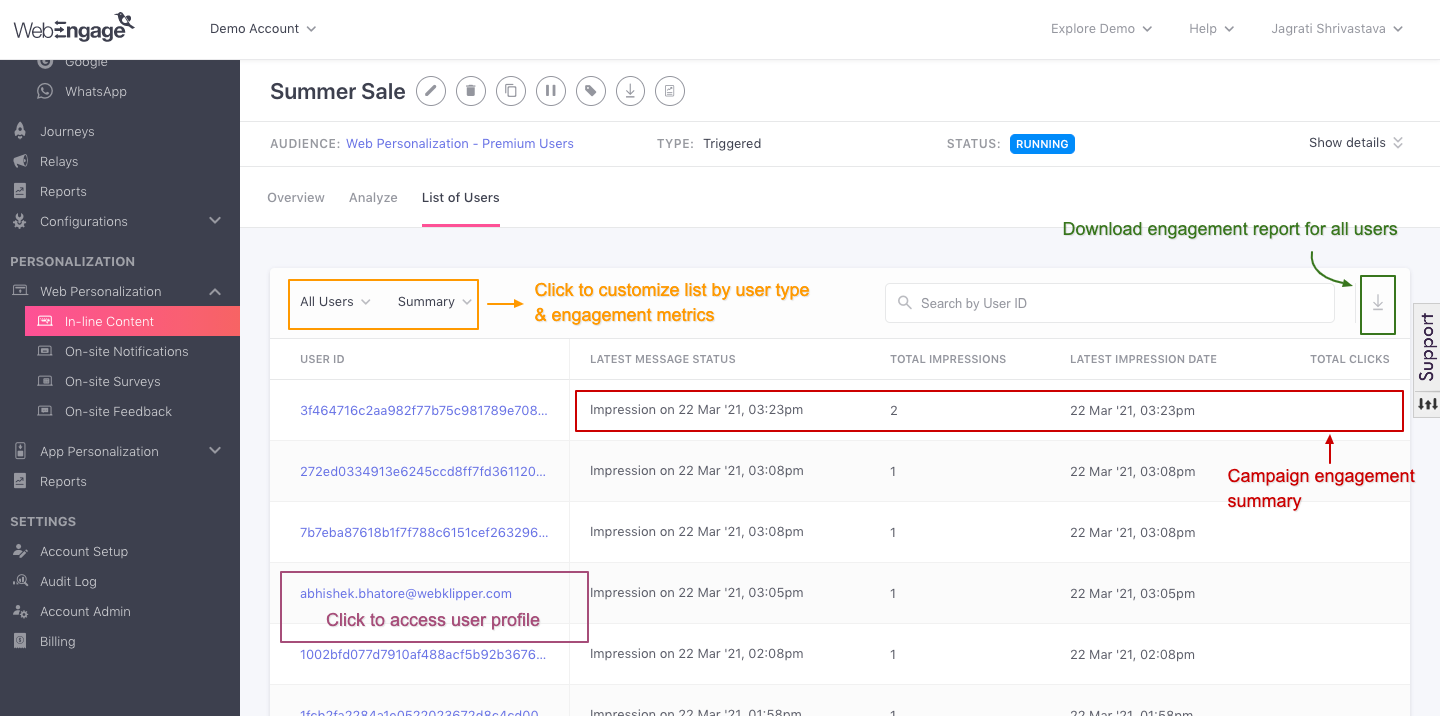
Click to enlarge
Filtering the List
Here's how you can filter the List of Users as per your analytical needs:
Select a Parameter

Click to enlarge
As shown above, using the dropdown placed on the top left, you can filter the List of Users by selecting a parameter.
The following options can be selected here:1. Summary: Shows you an overall summary of all the users included within the target audience, against the following columns:
Latest Message Status: Indicates the status of the message sent to the user with a date-time stamp as any one of the following:
- Impression on (date-time)
- Closed on (date-time)
- Clicked on (date-time)
- Converted on (date-time)
- Added to Control Group on (date-time): Shown for all users who were not sent the campaign as they were added to the Control Group, as specified by you while creating the campaign.
Total Impressions: Indicates the total number of times the user viewed the Web In-line Banner.
Latest Impression Date:** Indicates the date-time on which the latest view occurred.
Total Clicks: Indicates the total number of times the user has clicked on the Web In-line.
Latest Click Date: Indicates the date-time on which the latest click occurred.
2. Impressions: Helps you analyze all the users that have seen the Web In-line campaign against the following columns:
Total Impressions
Latest Impression Date**
3. Clicks: Helps you analyze all the users who have clicked on the campaign over its entire lifetime against the following columns:
Total Clicks
Latest Click Date
4. Conversions: Helps you analyze all the users that have performed the campaign's Conversion Event, over its entire lifetime, against the following columns:
Total Conversions: Indicates the total number of times the user performed the Conversion Event within the specified deadline.
Latest Conversion Date: Indicates the date-time on which the latest conversion occurred.
Latest Conversion Type: Indicates the campaign event Views, Clicks to which the conversion was attributed to as Click-through Conversion Impression-through Conversion or Send-through Conversion.
Revenue: Indicates the total amount of Revenue contributed by the user (calculated against Total Conversions).
(Detailed read on what each performance indicator denotes)
5. Control Group: Lists down all the users who have been added to Control Group. Here you can view the control group (Universal, Custom) of which the user is a part of along with the date and time in which they were added to it for the campaign
Download List
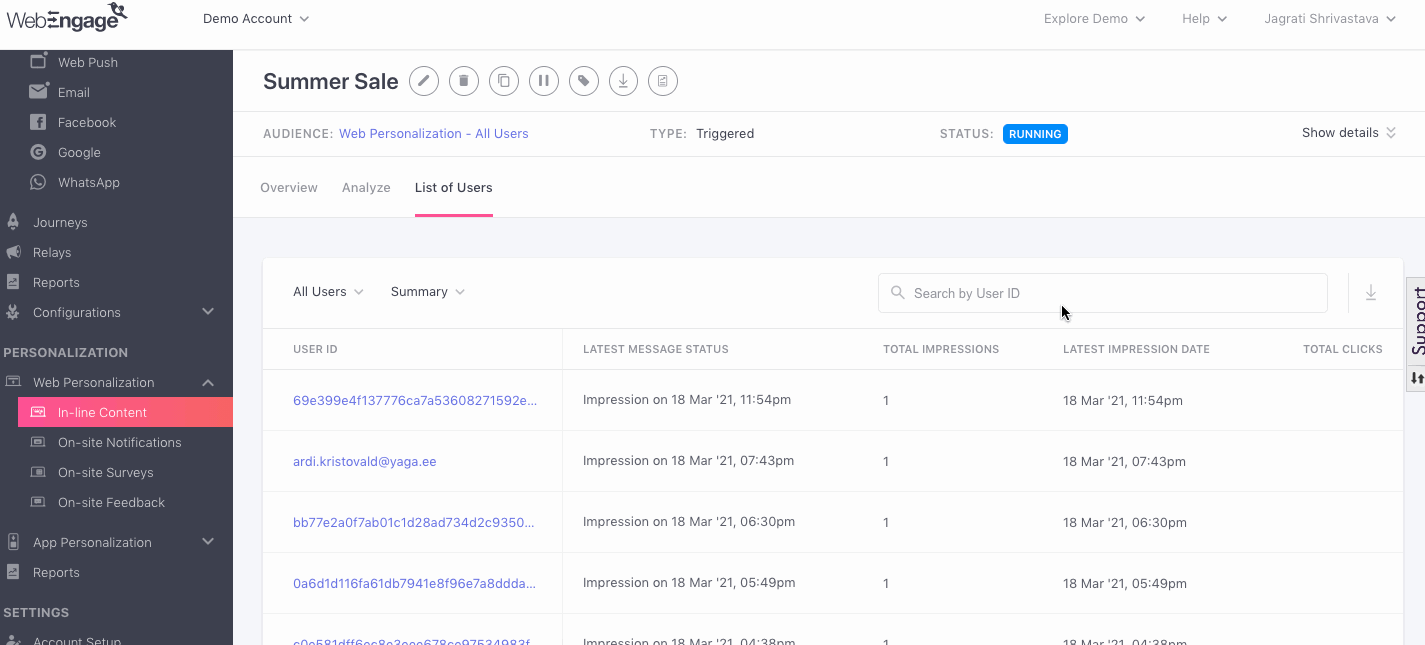
Click to enlarge
As shown above, using the Download icon placed on the top right of the table, you can choose to download a user-wise engagement report for all the users targeted by the campaign over its entire lifetime. Here's how you can go about it:
Step 1: Click the Download icon.
- In doing so, you will be prompted with a pop-up to re-confirm your decision.
Step 2: Click the Download button on the pop-up window to proceed.
- An email containing a link to the downloadable file will be sent to your registered email address shortly.
Search for a User
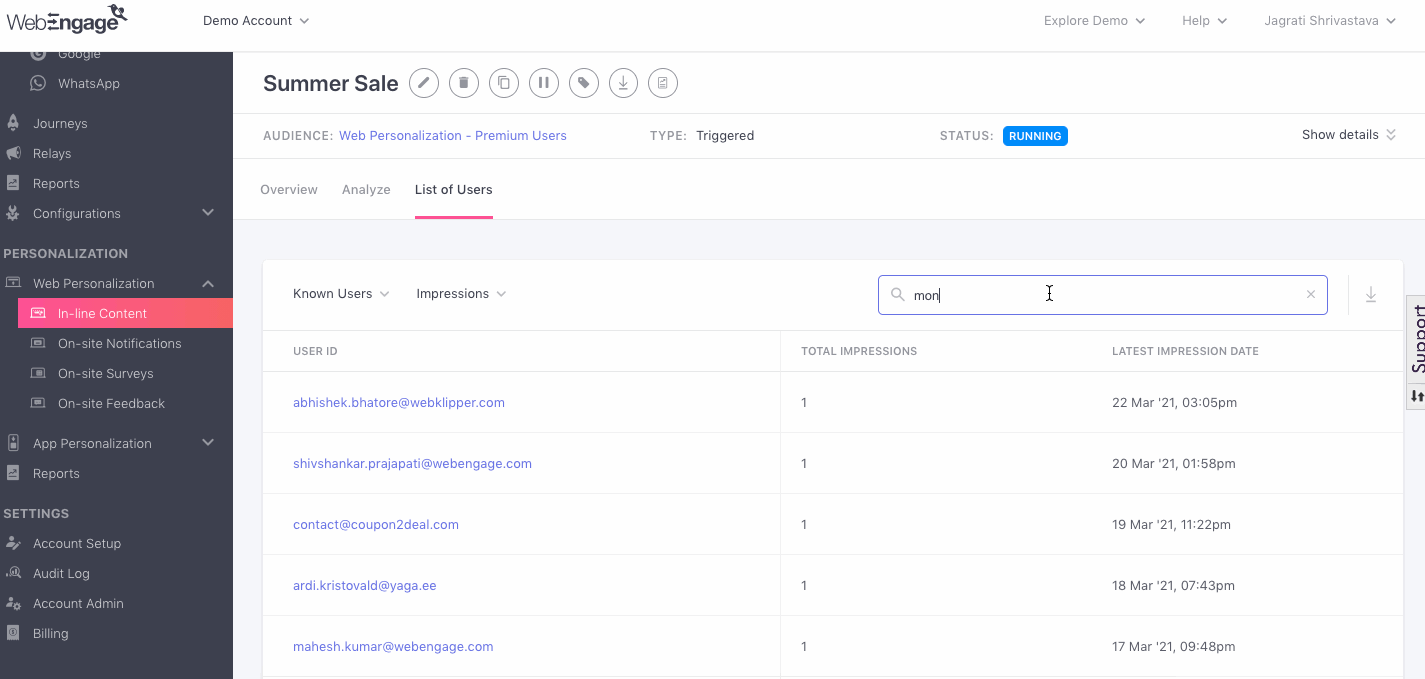
Click to enlarge
As shown above, using the search box placed on the top right, you can dig into the engagement status of a particular user by searching for their User ID.
Why is the same User ID shown in multiple rows?As visible in the above visual, multiple rows get populated with the same User ID on searching for a user. Each row contains a different message status with a varying date-time of Impression and Conversion.
This is because the user chose to perform the trigger event twice and was sent the triggered Web In-line campaign twice as a result. Thus, if a triggered campaign is sent to a user multiple times, you will be able to analyze their interaction with each run of the campaign, as shown above.
Access User Profiles
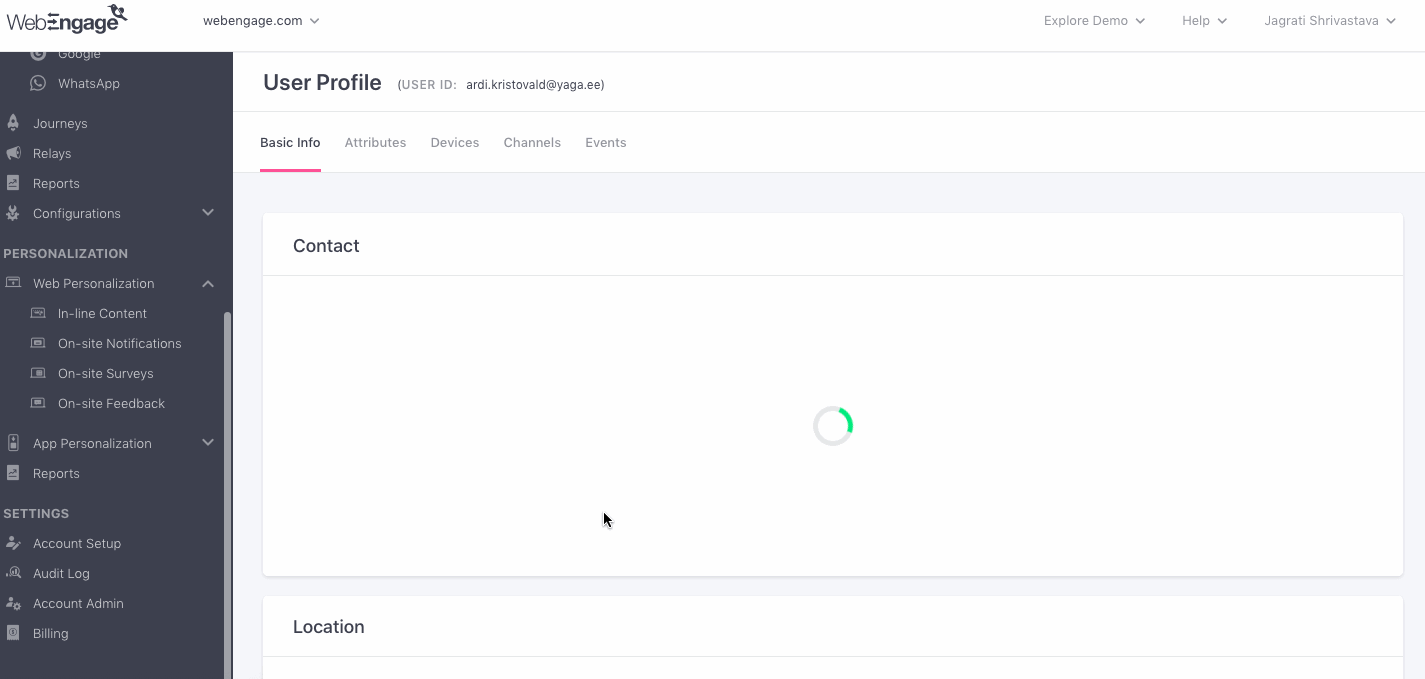
Click to enlarge
As shown above, you can access the profile of a user targeted by the campaign by clicking their (hyperlinked) User ID. Doing so will help you analyze the user's channel preferences, personal details device preferences, latest interactions with your campaigns, app, website, the technical aspects of each interaction much more!
Must ReadPlease refer to Analyzing User Profiles for a robust understanding of how you can dig into the preferences and behavior of individual users.
We hope this has equipped you with a robust understanding of how you can mine valuable insights into a campaign to understand its real impact on user engagement and revenue. Please feel free to drop in a few lines at [email protected] if you have further queries. We're always just an email away!
Updated about 2 months ago